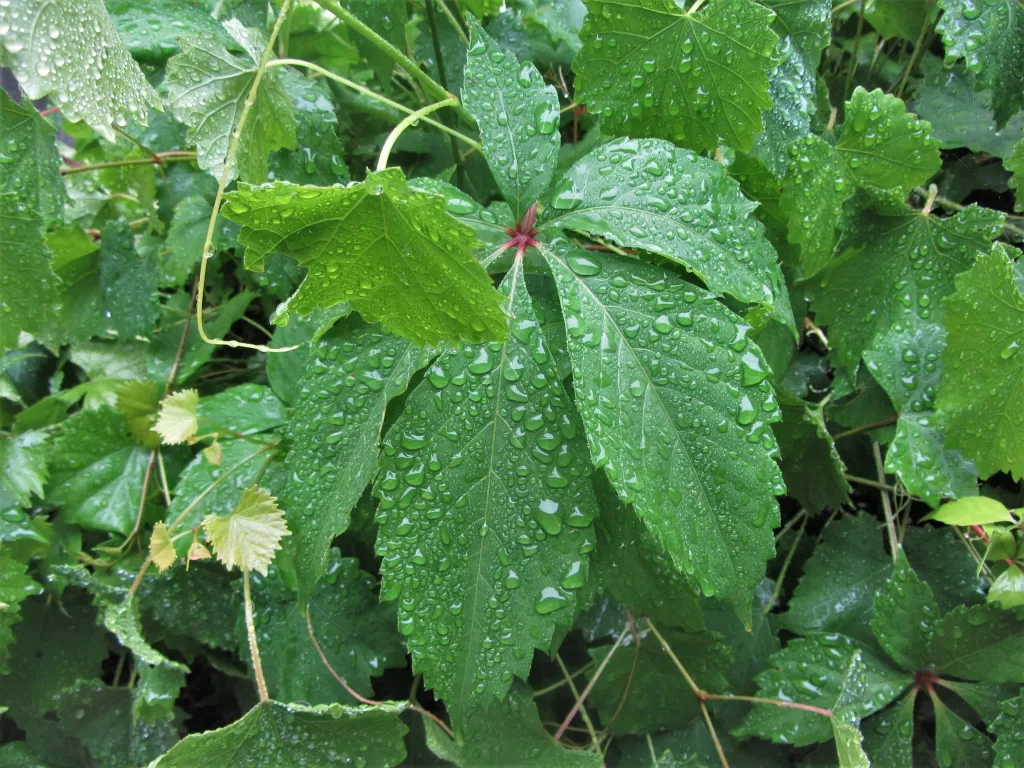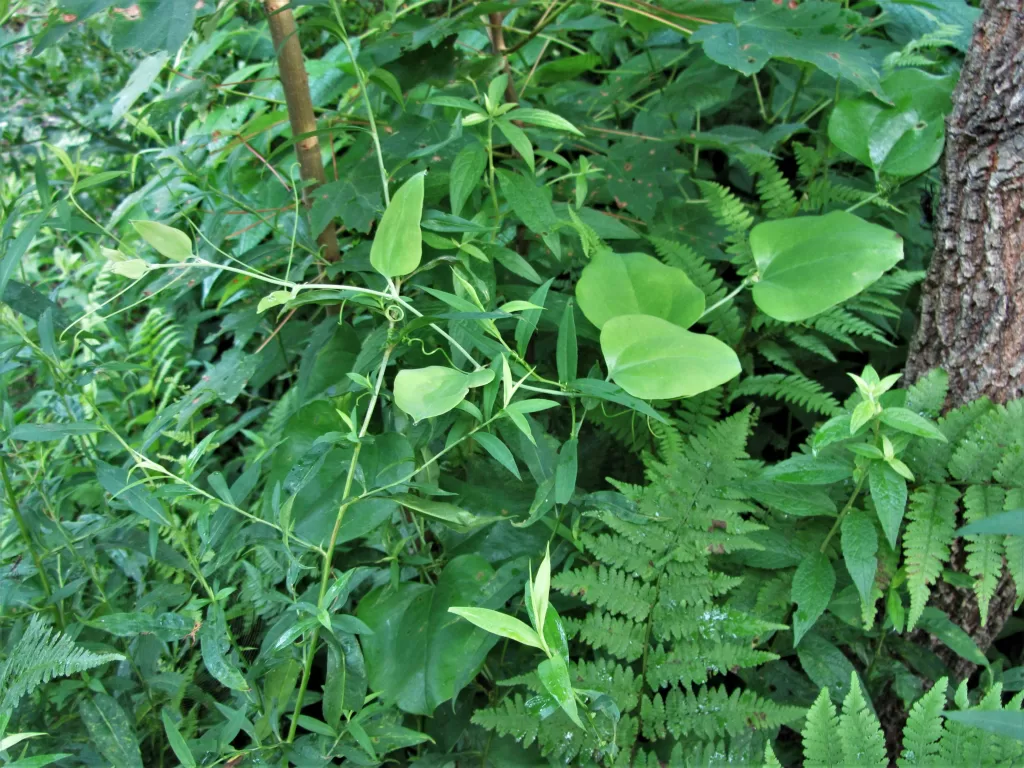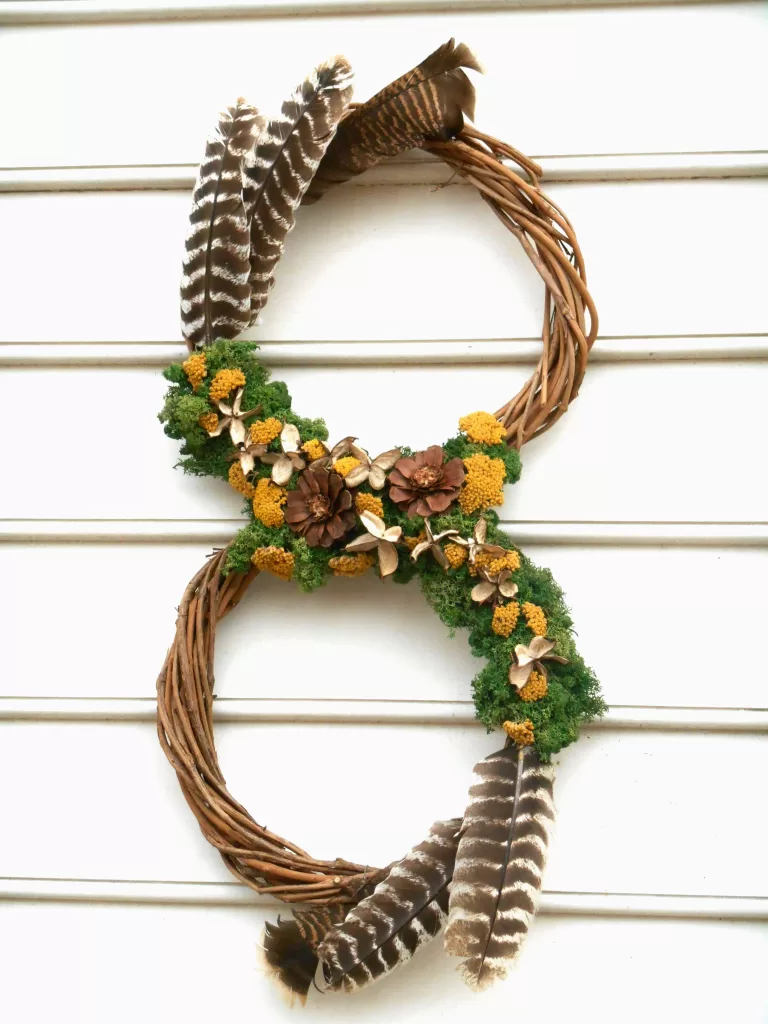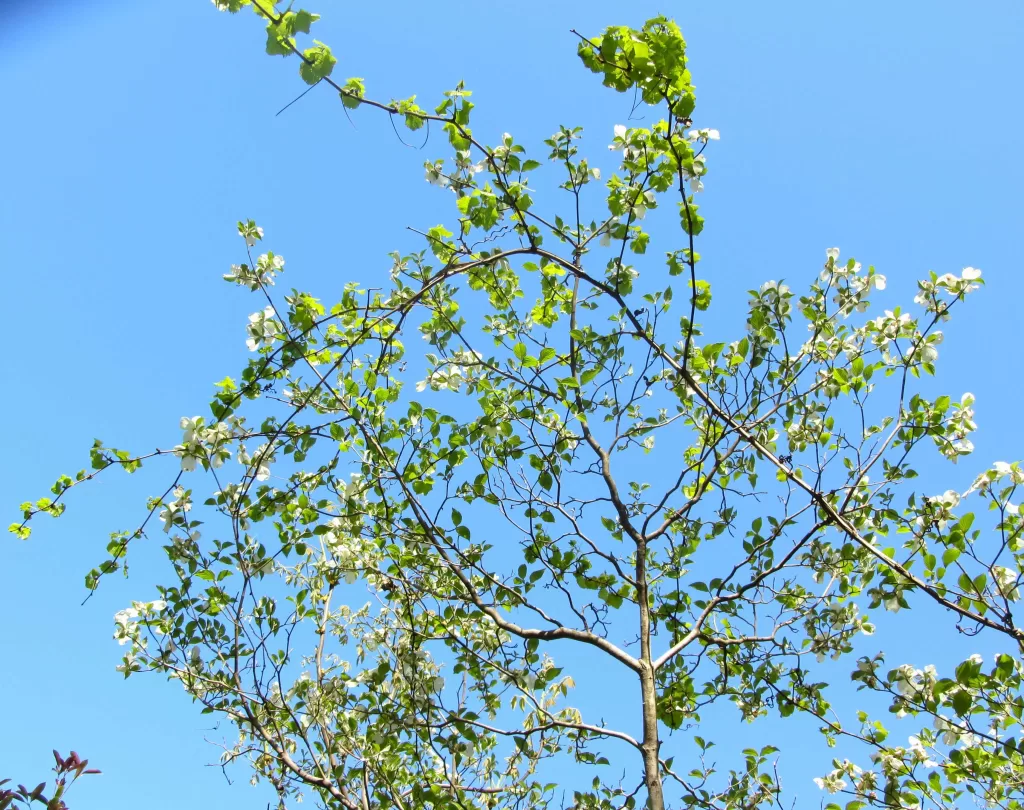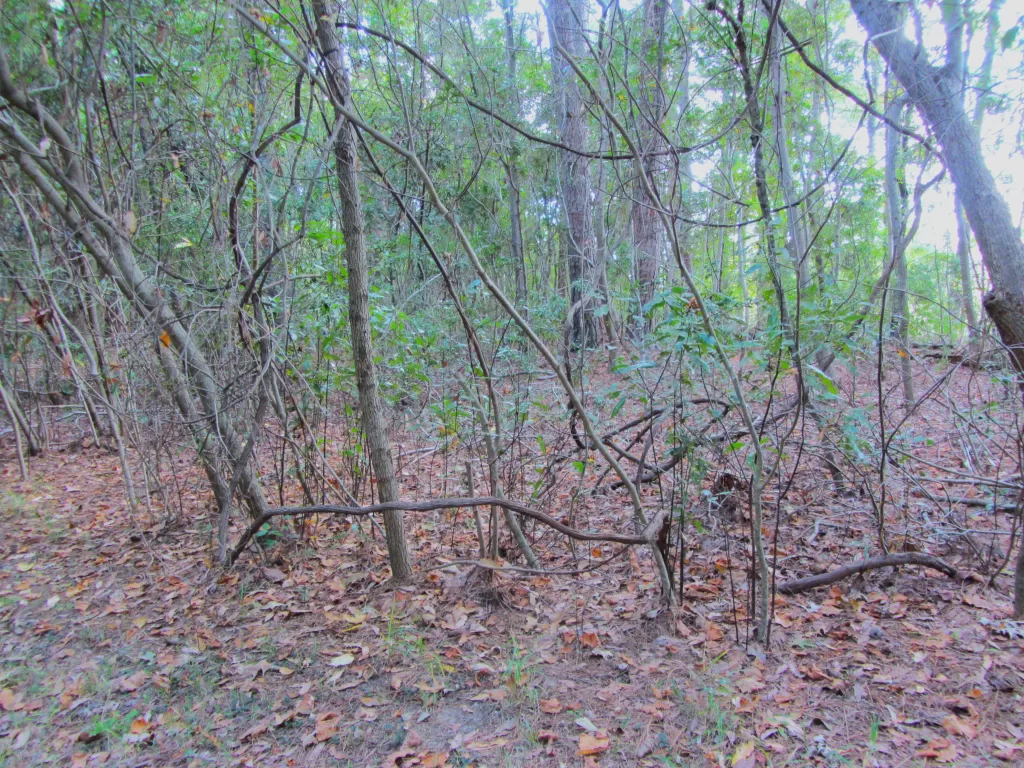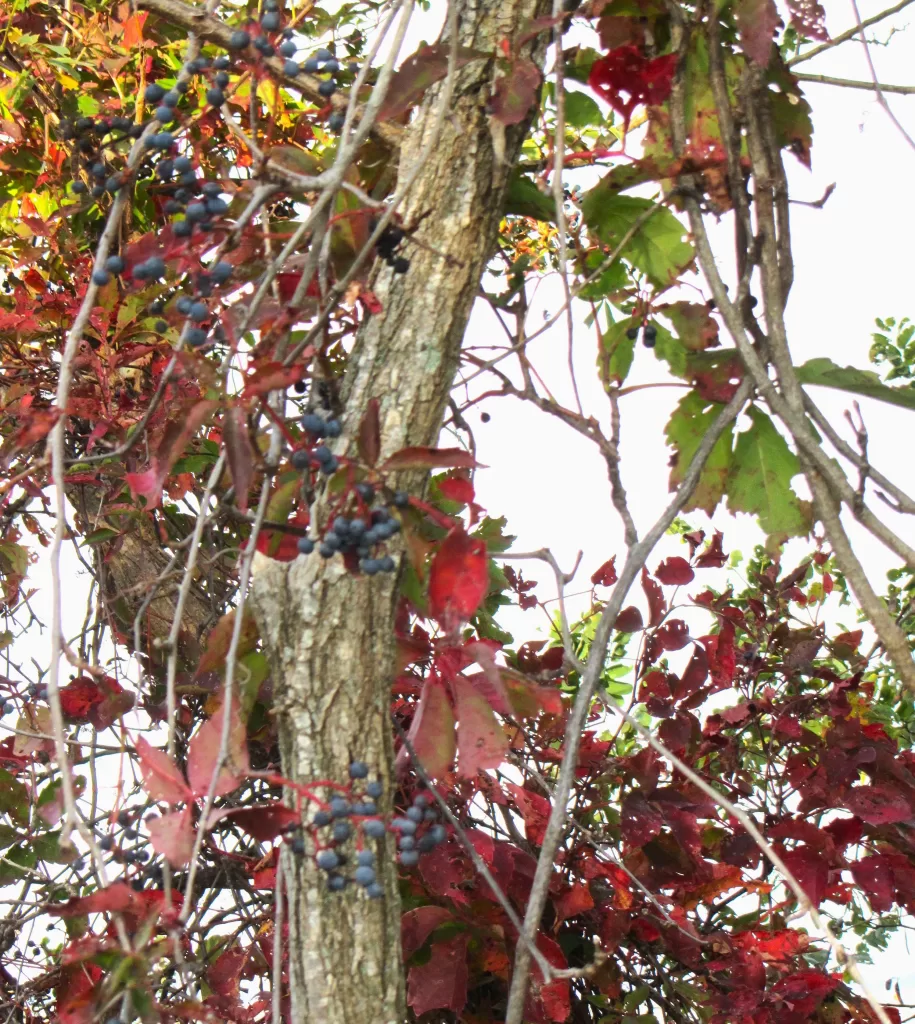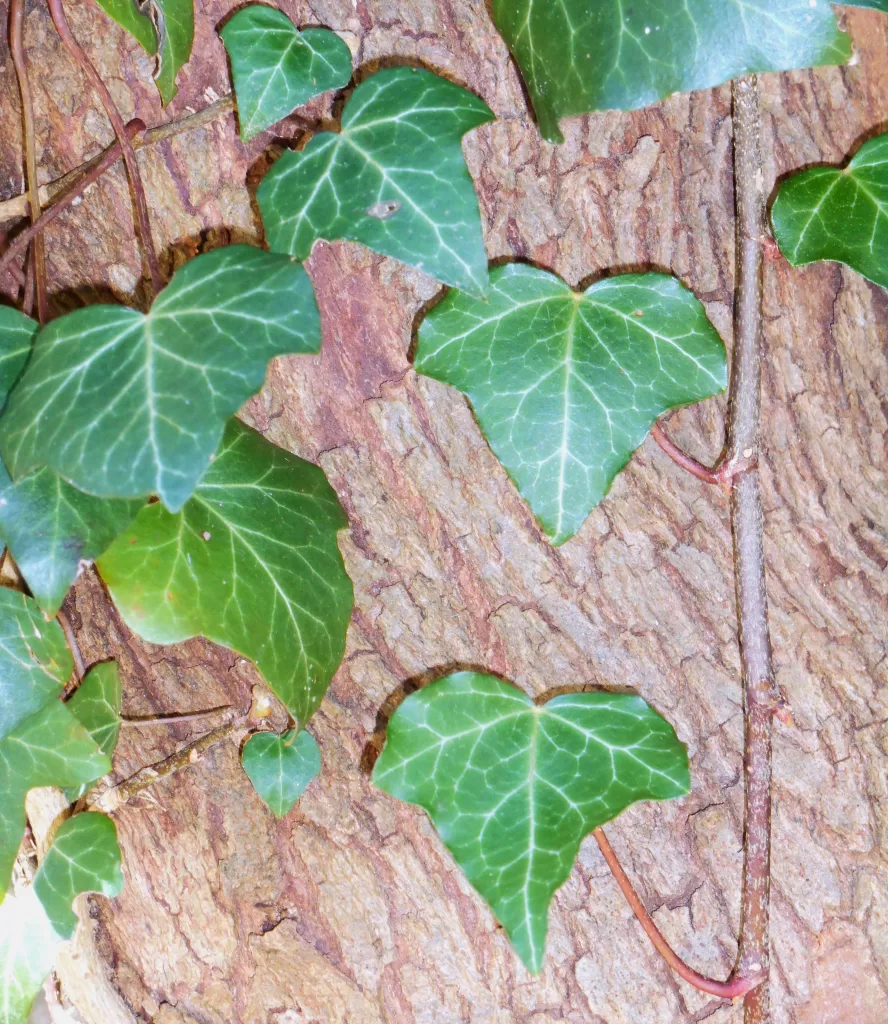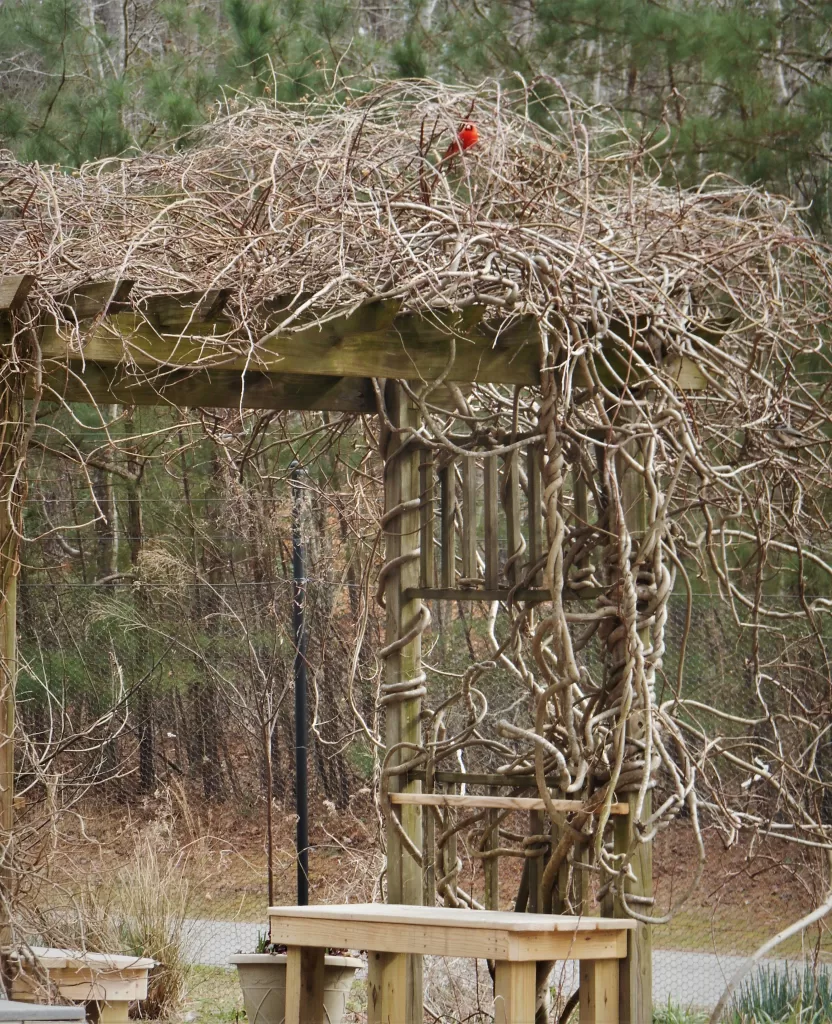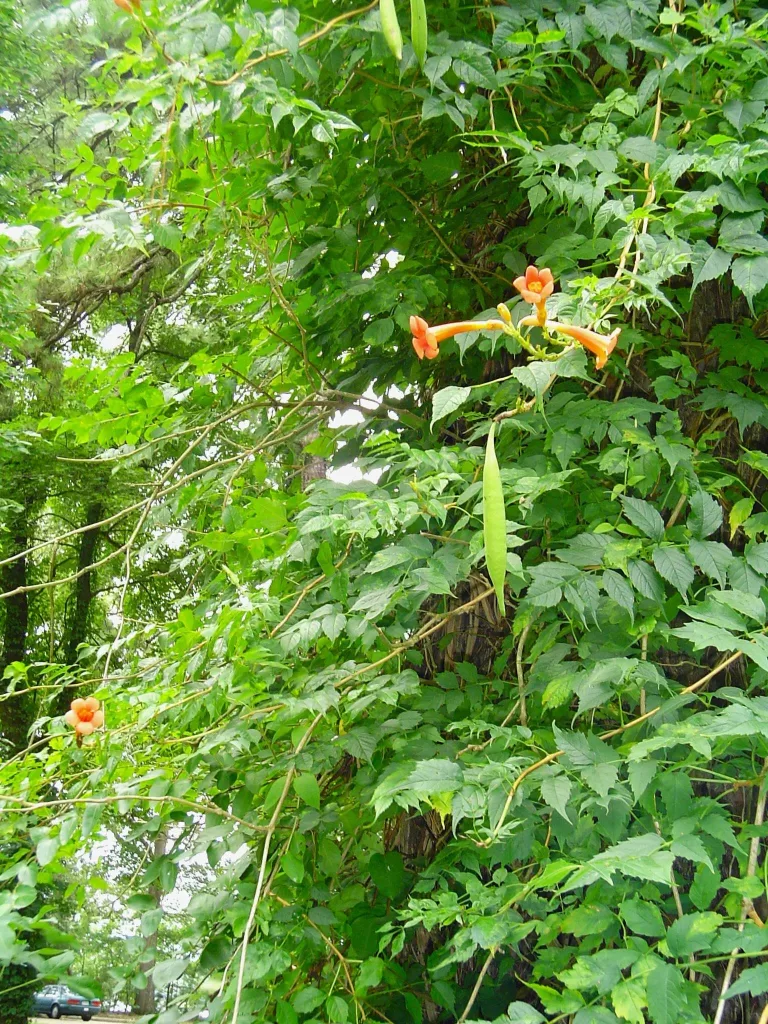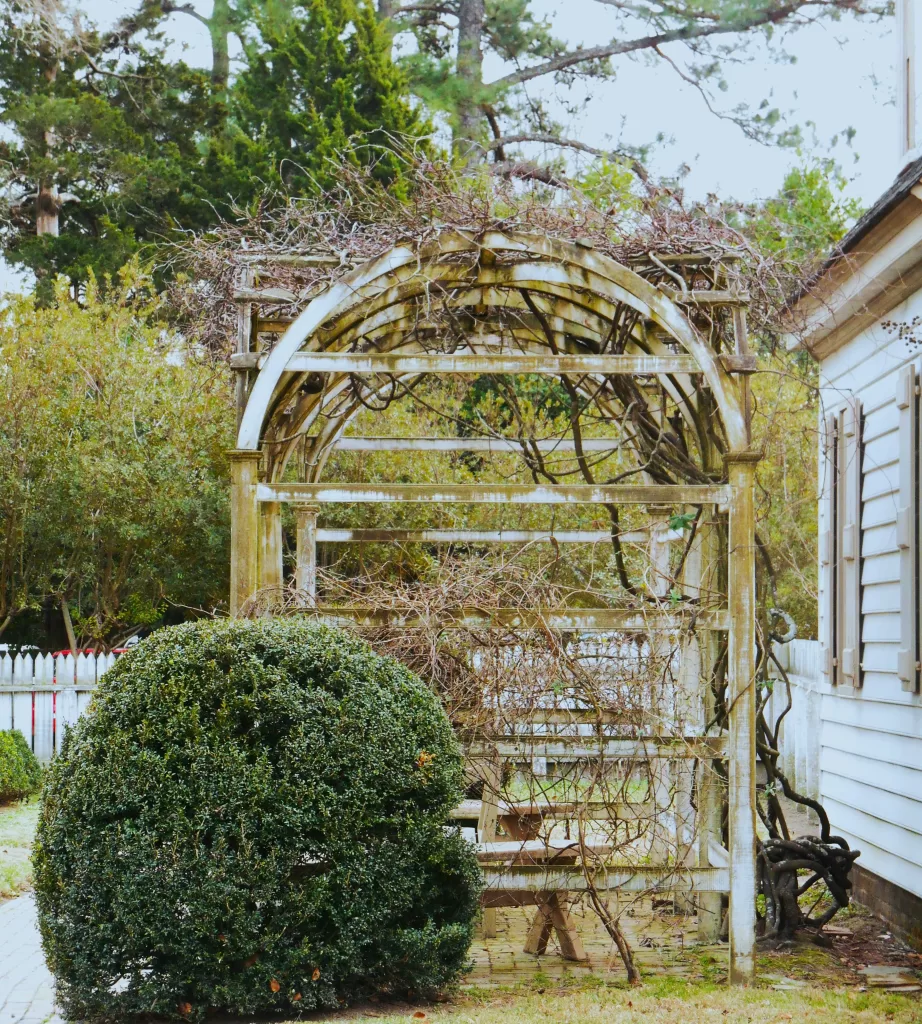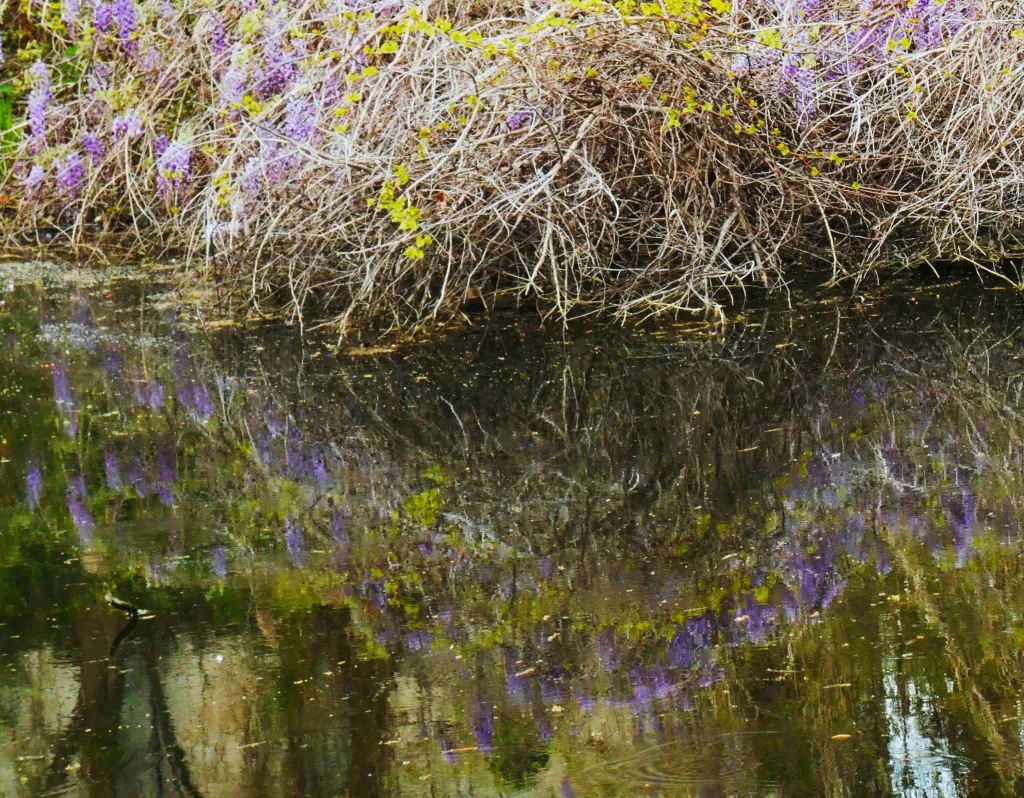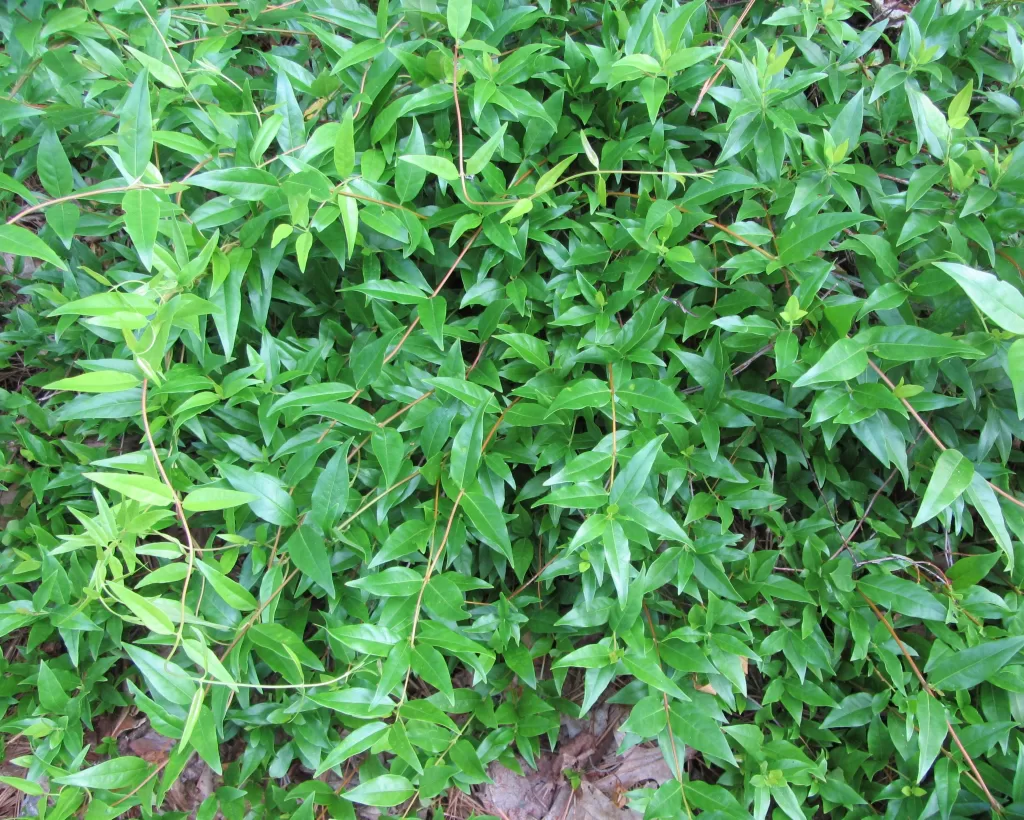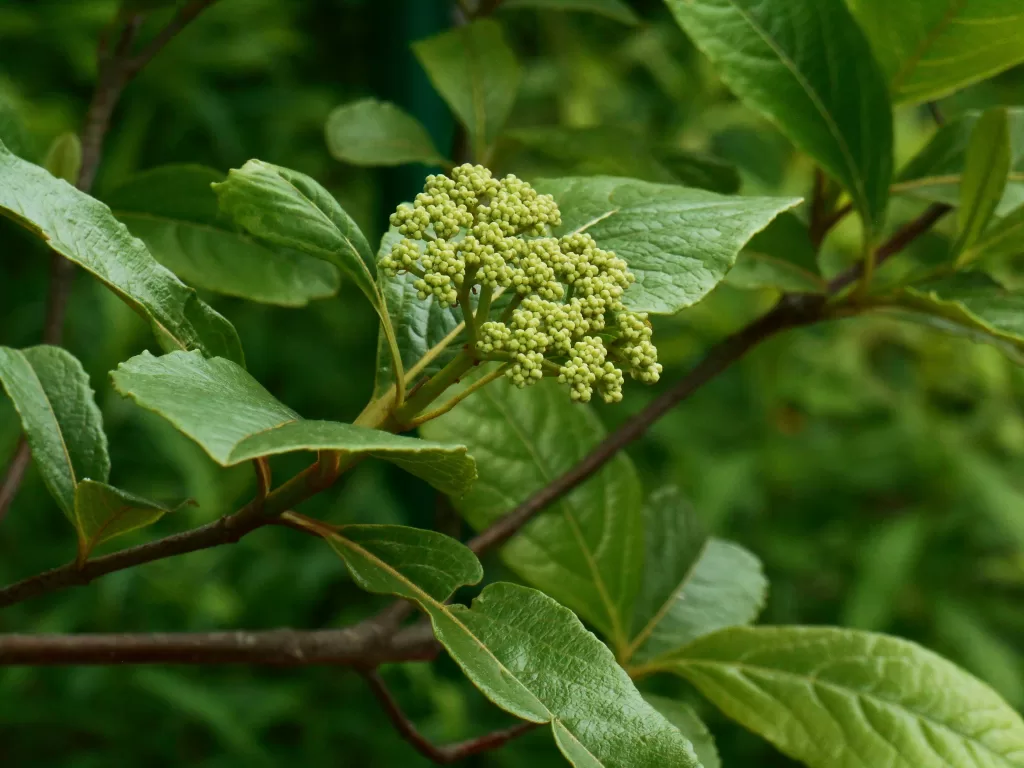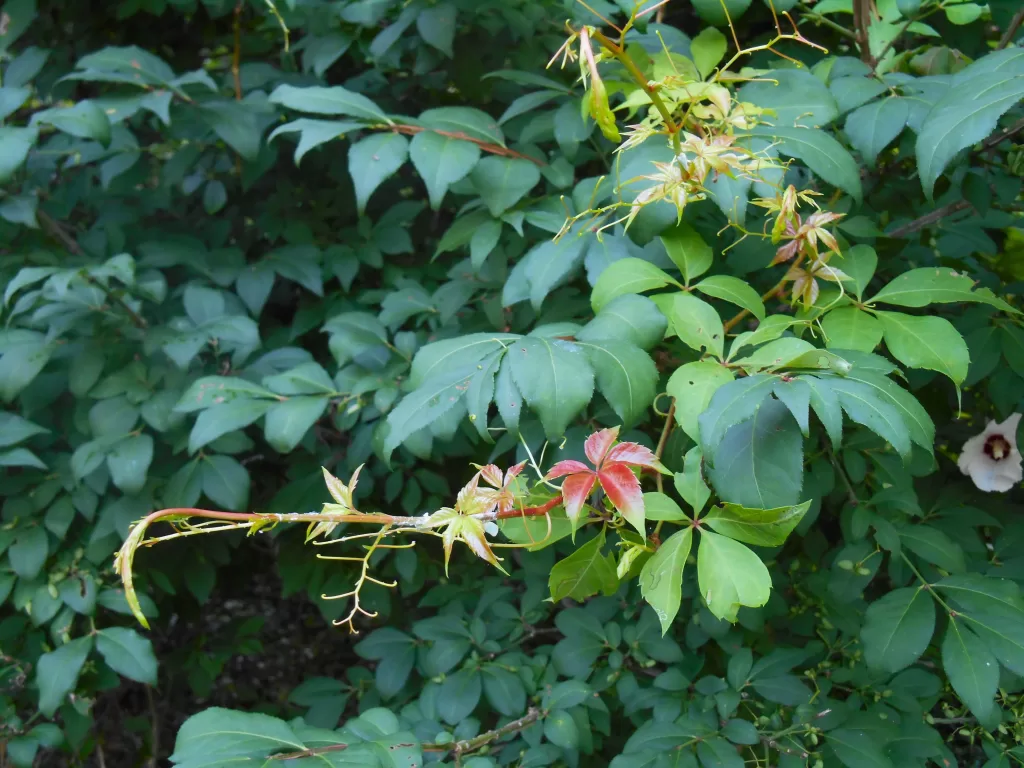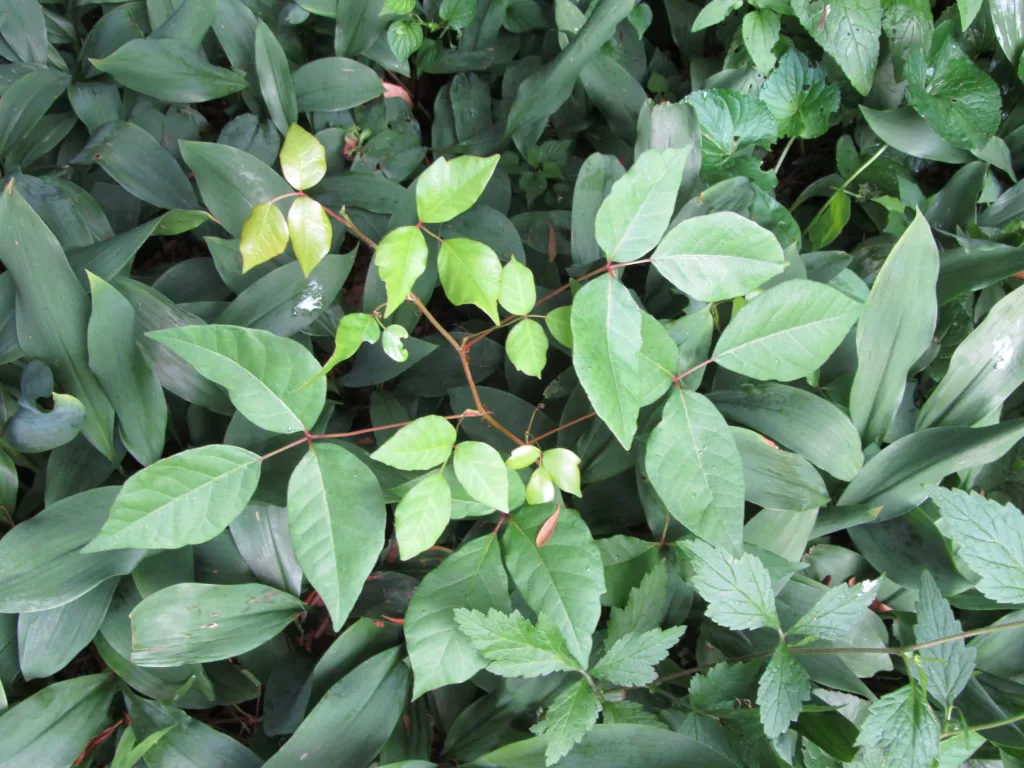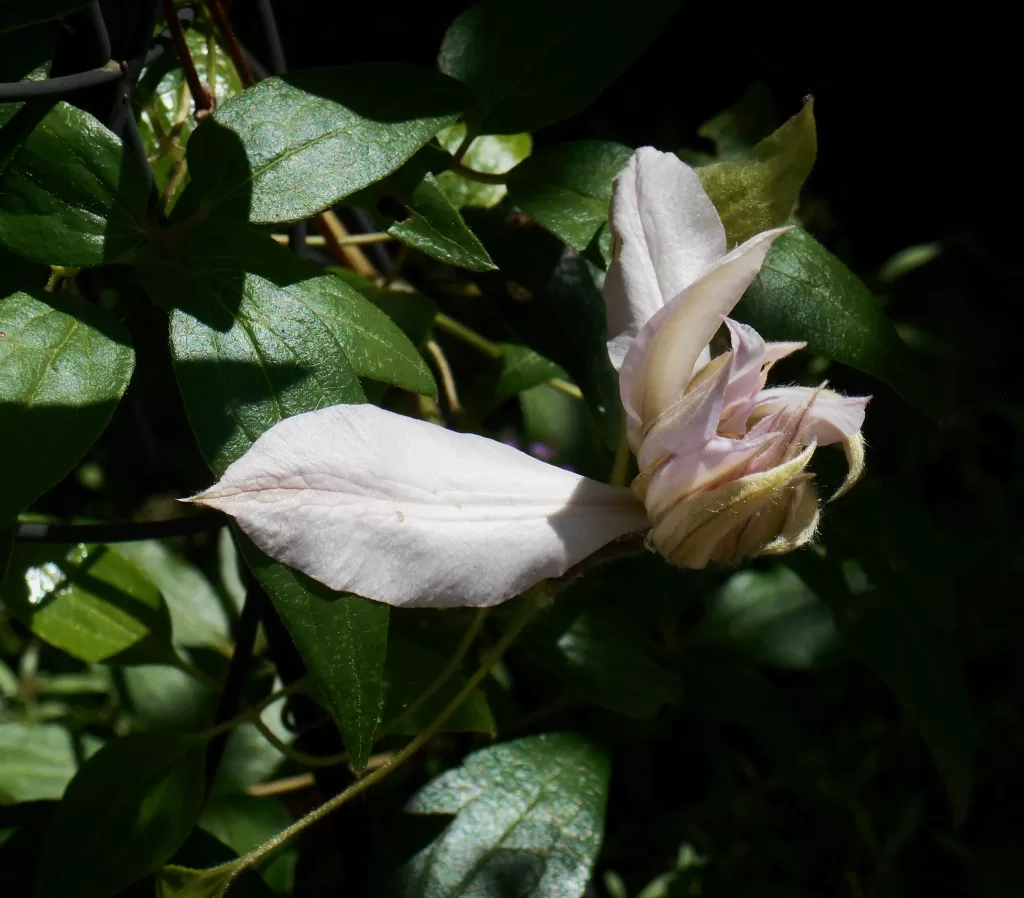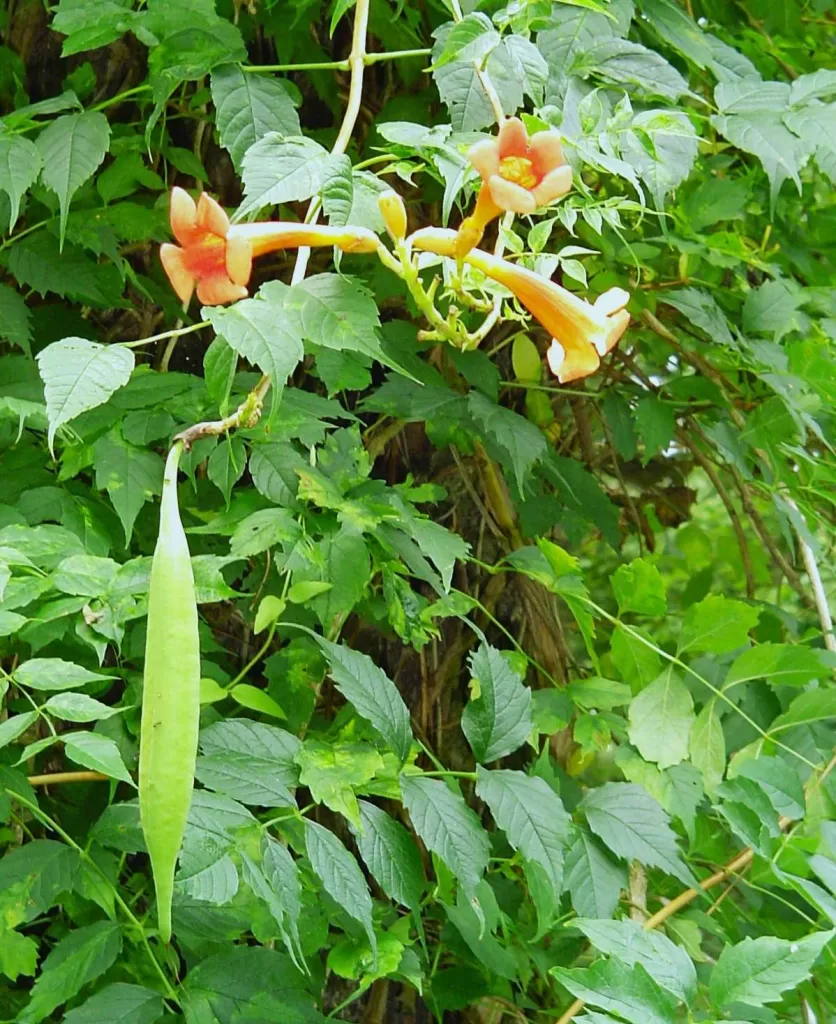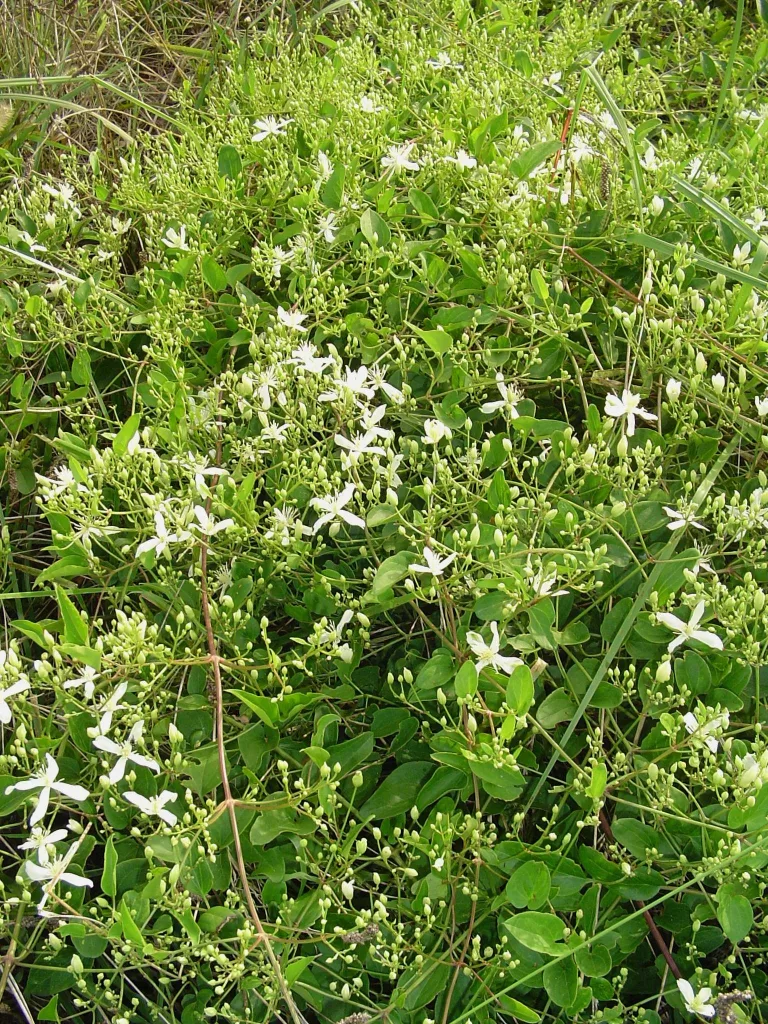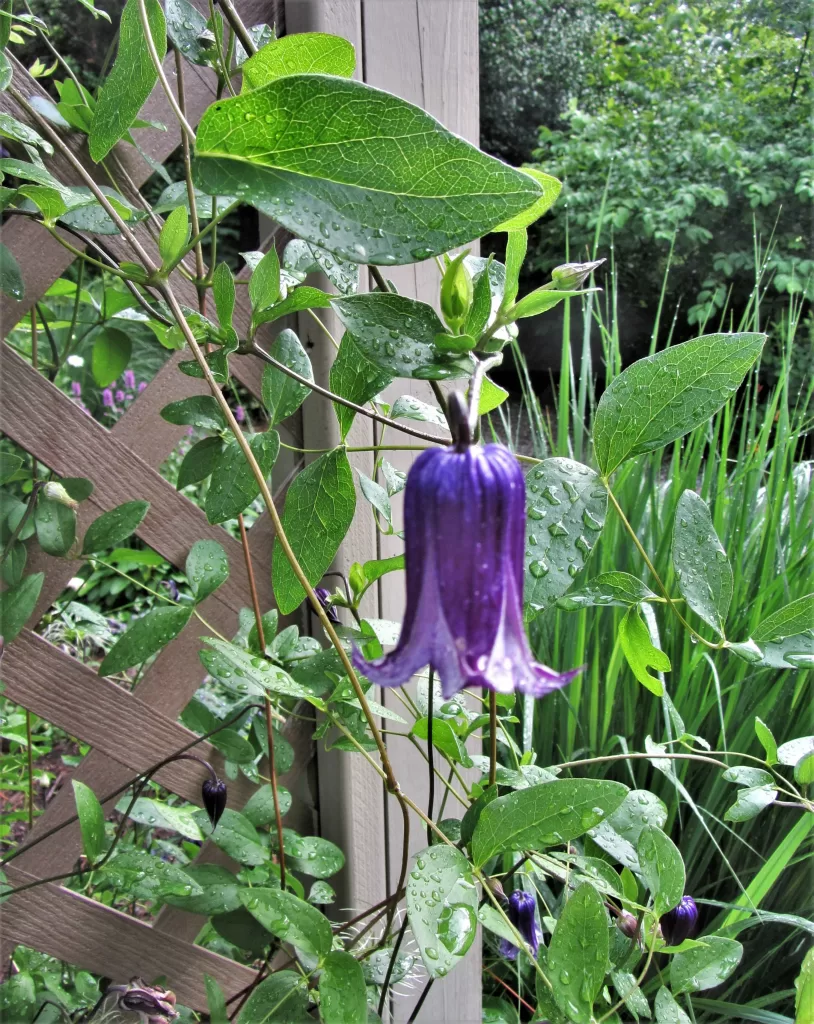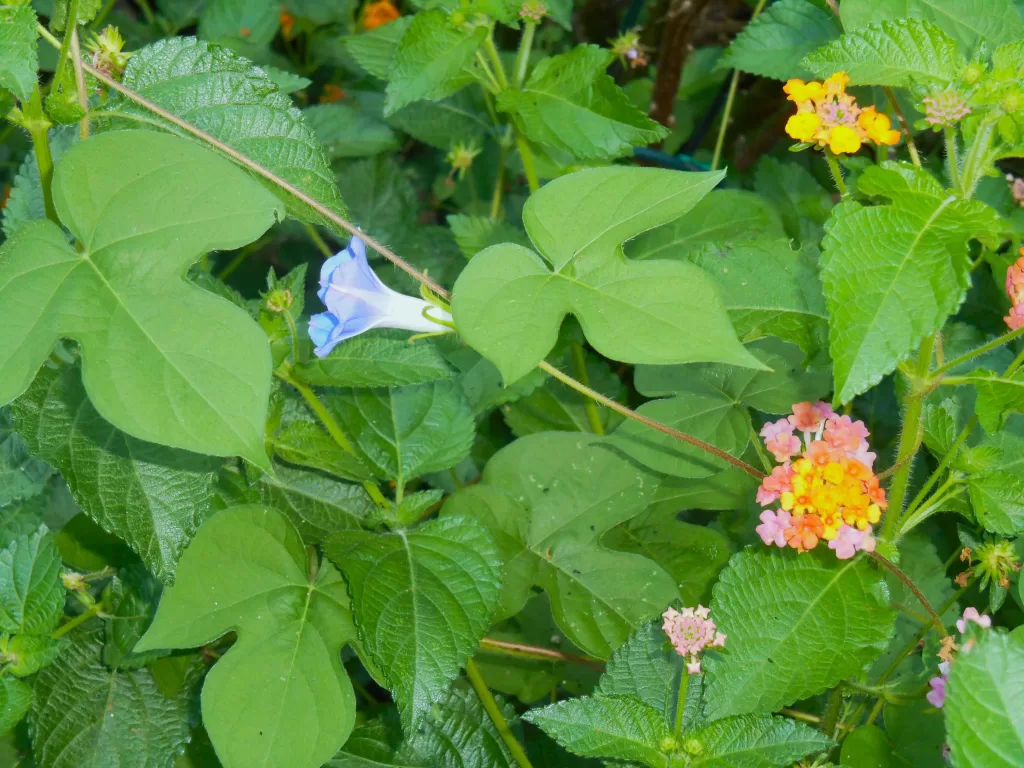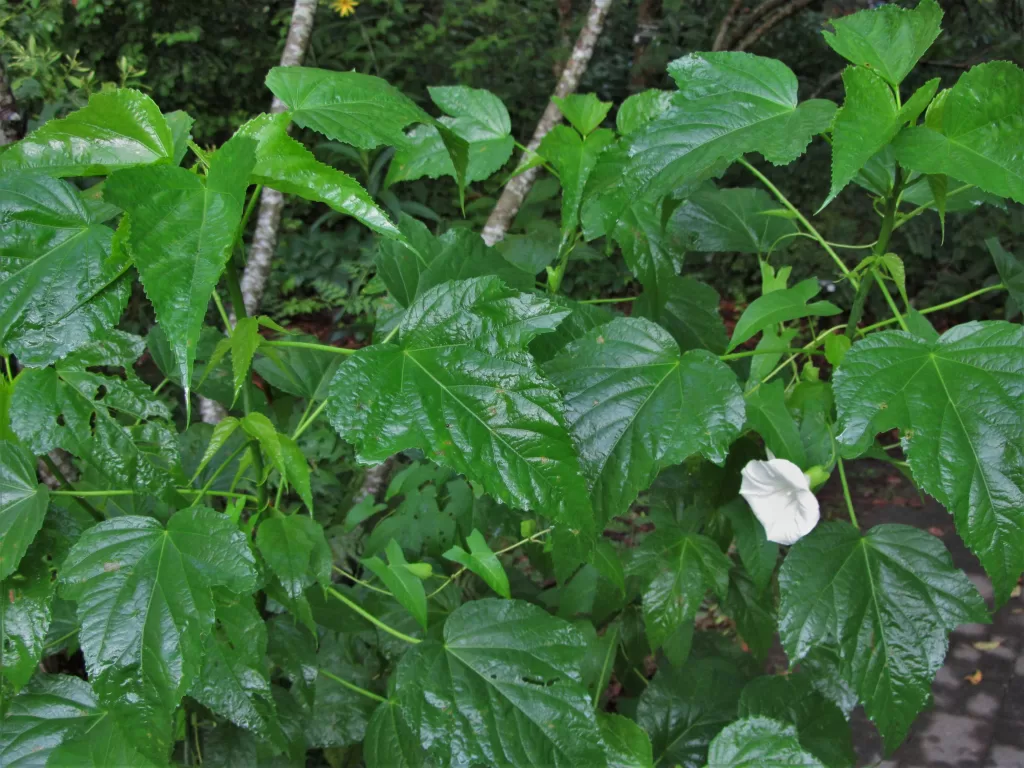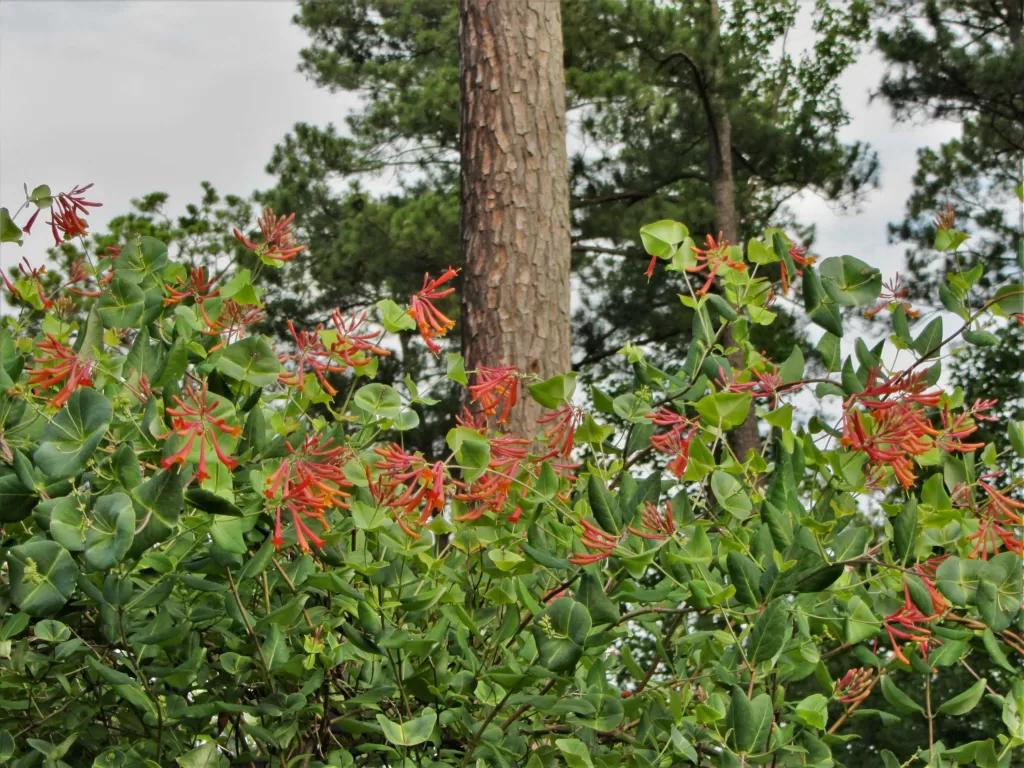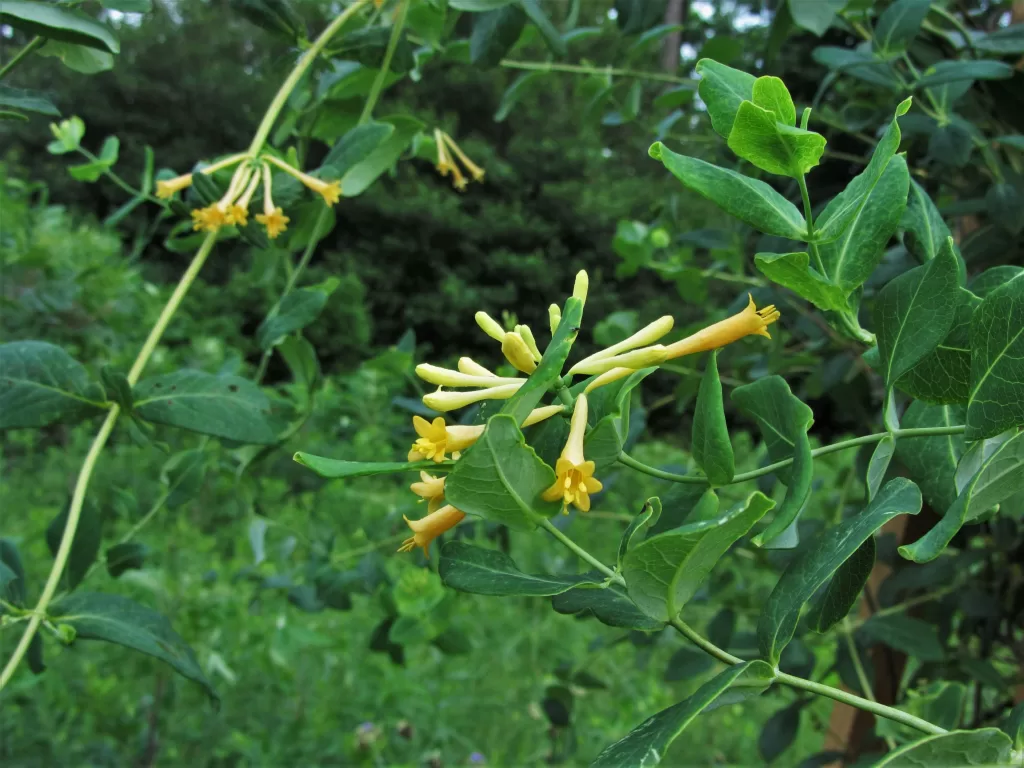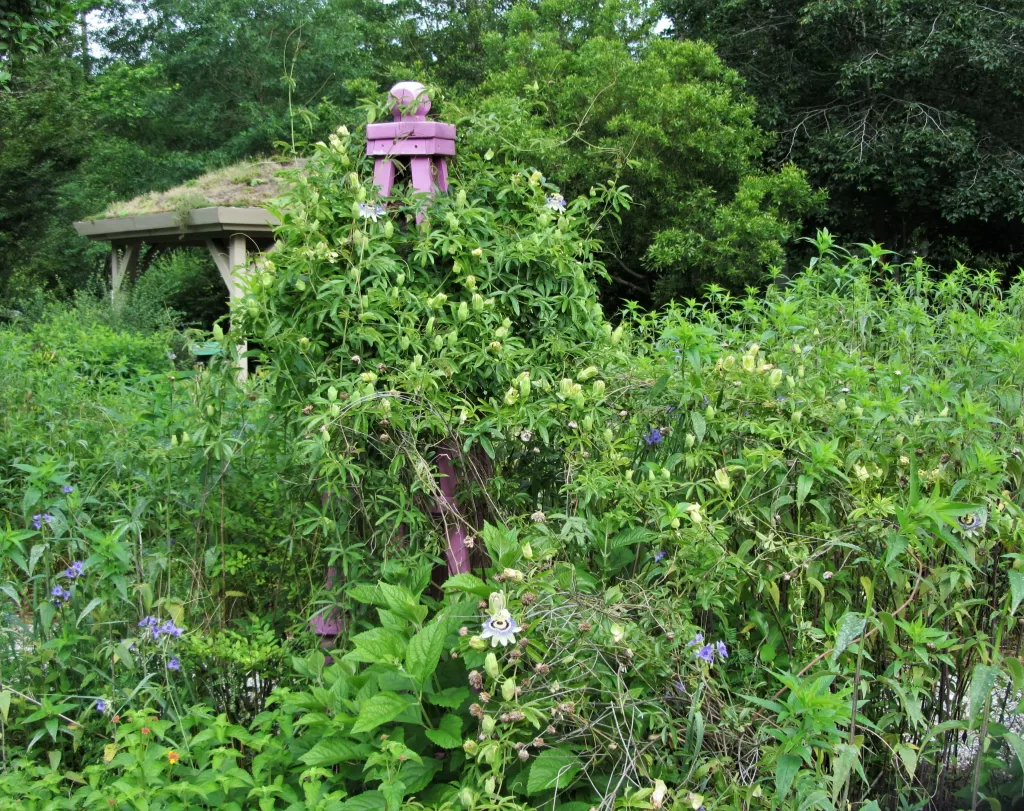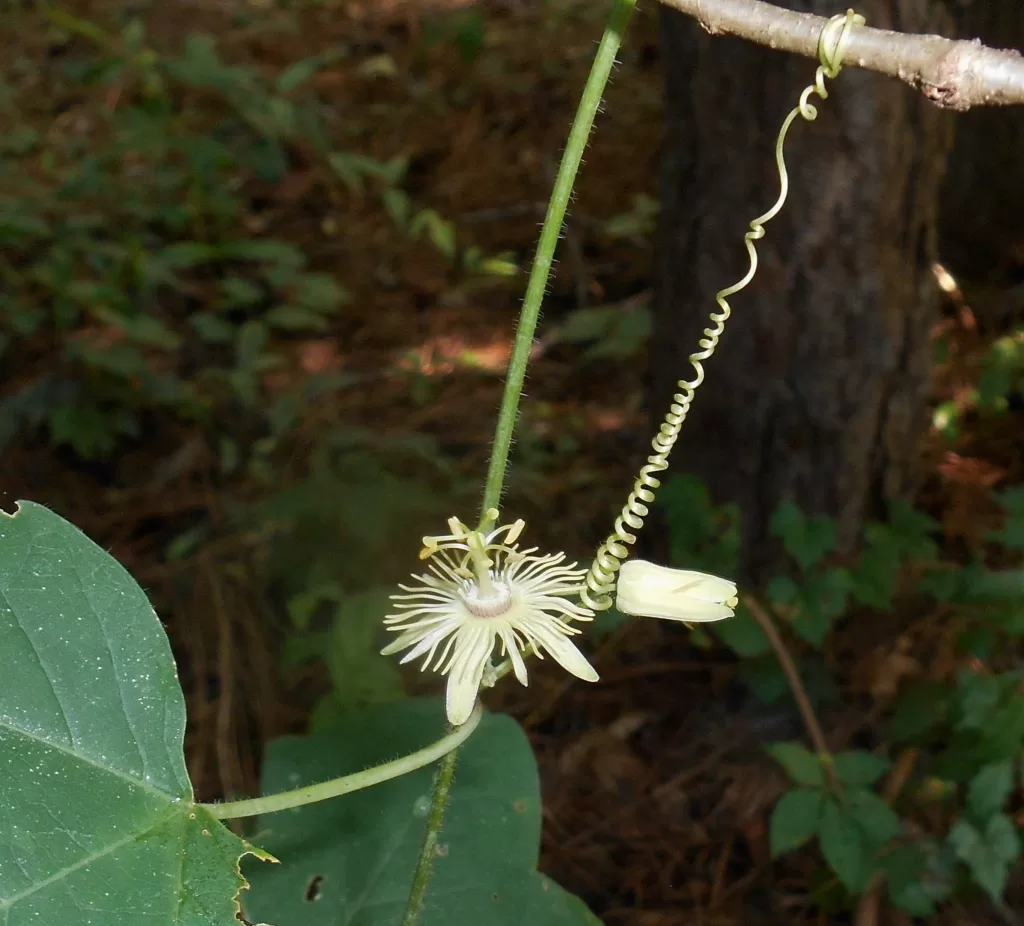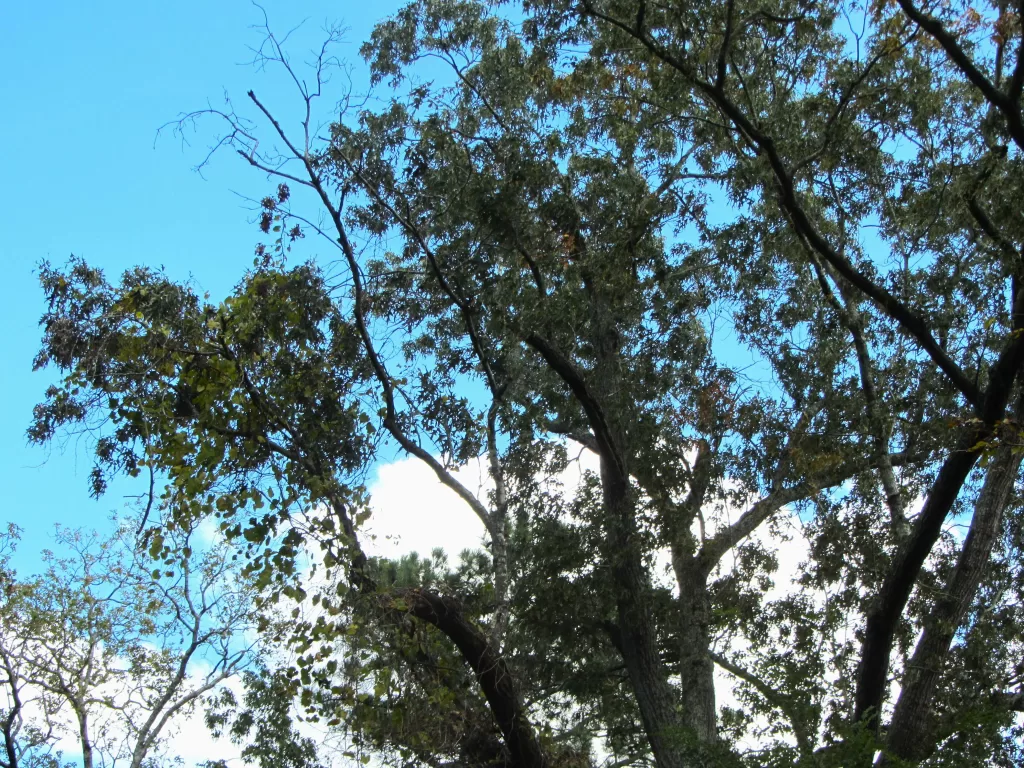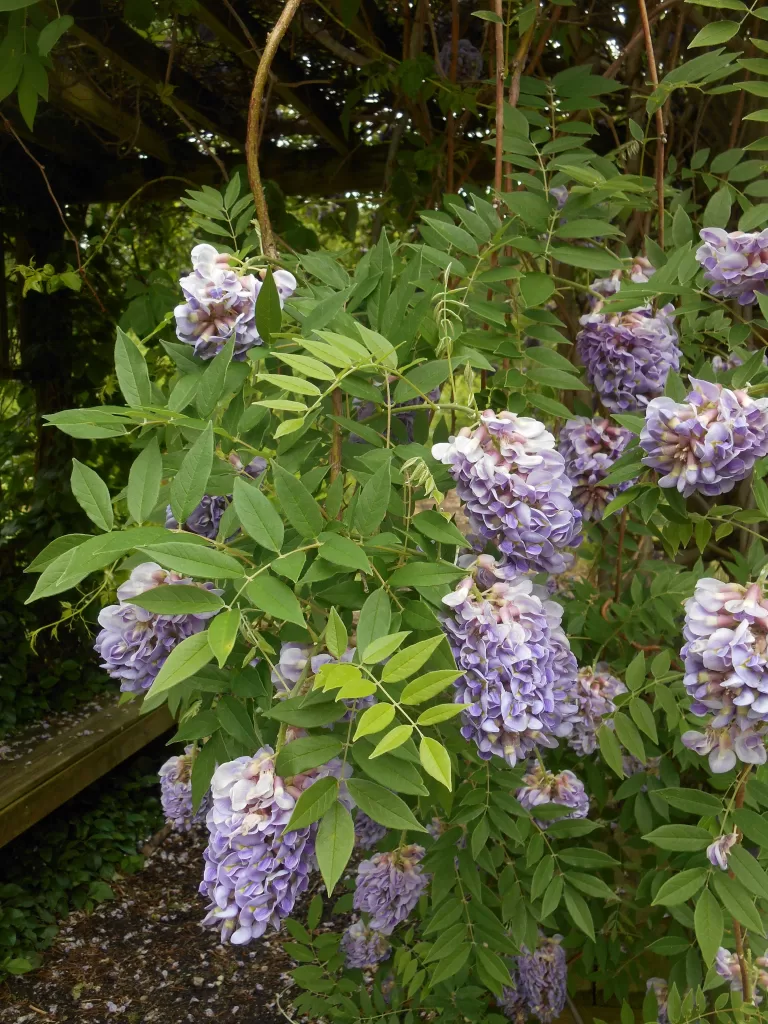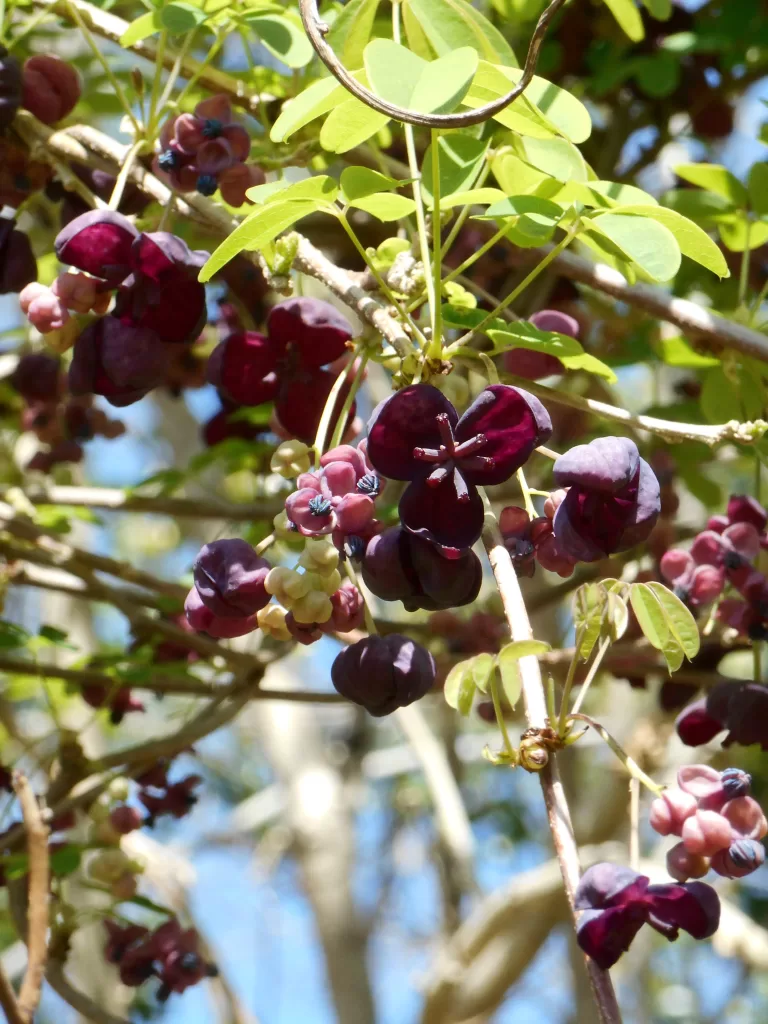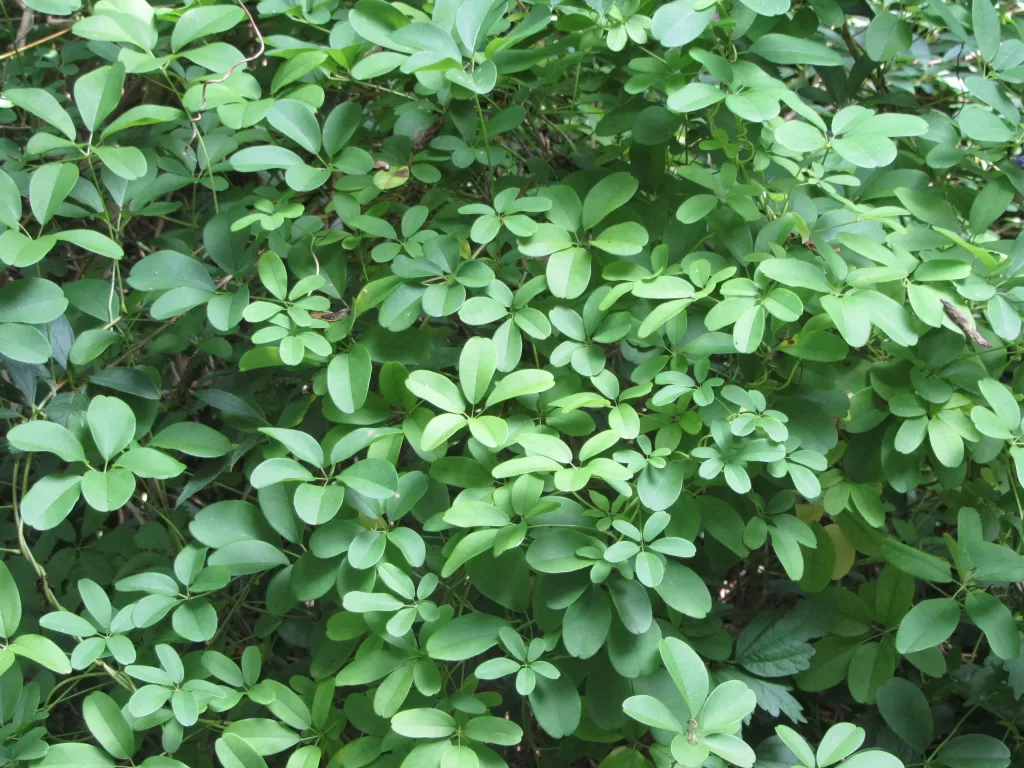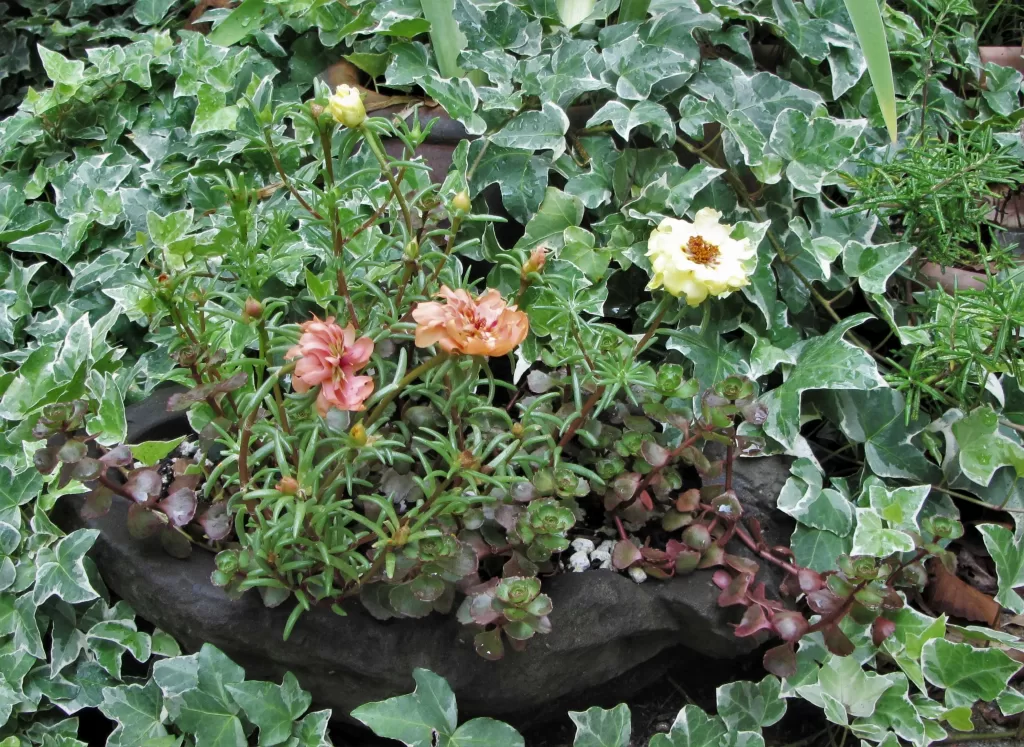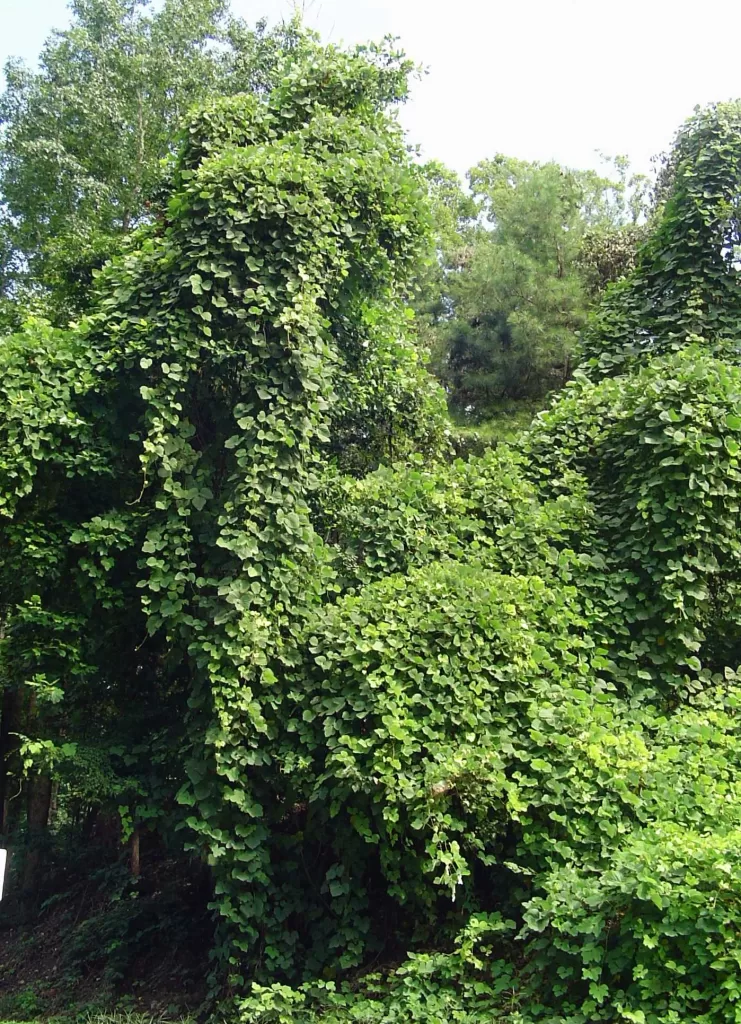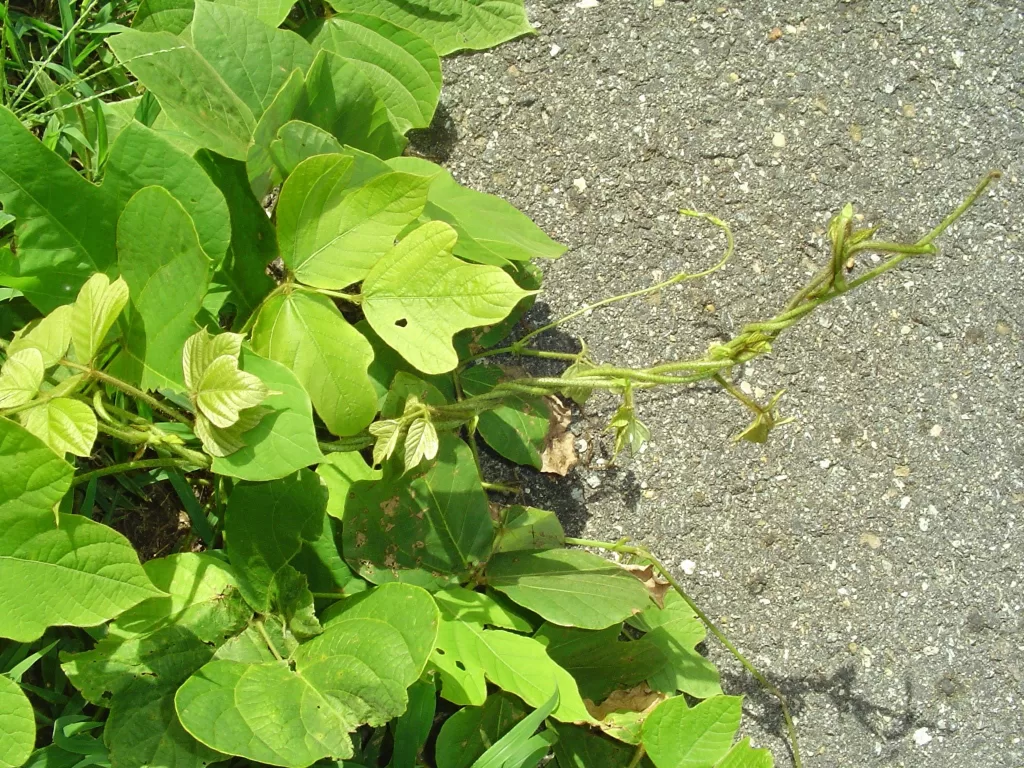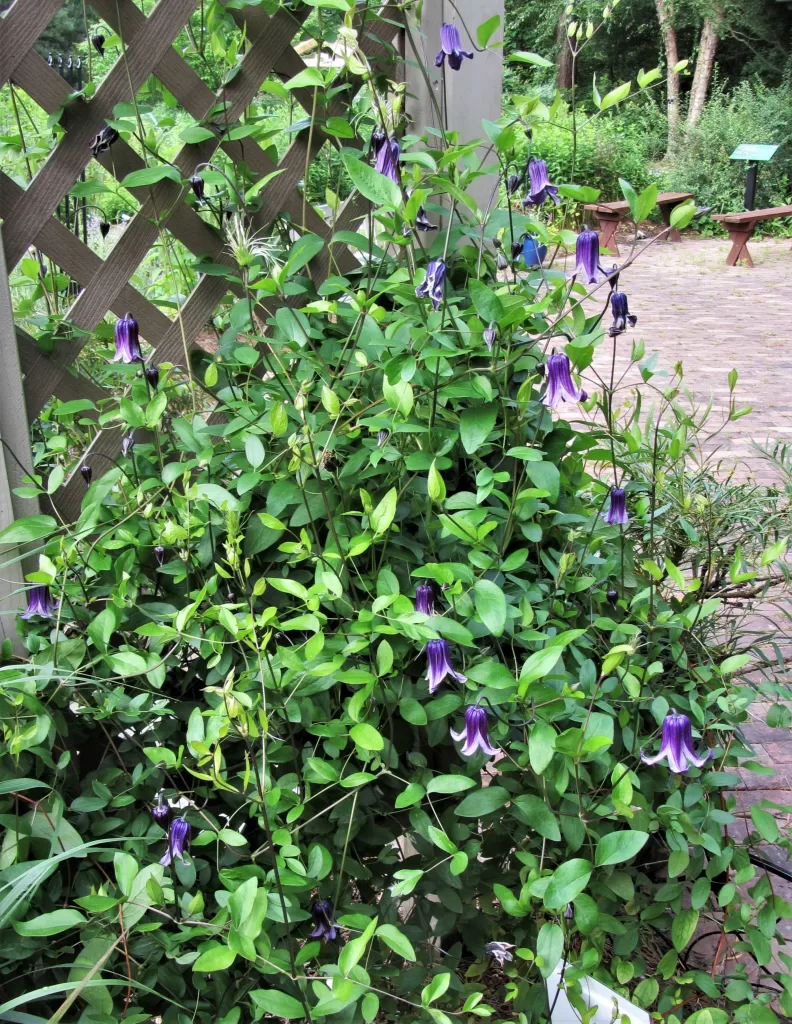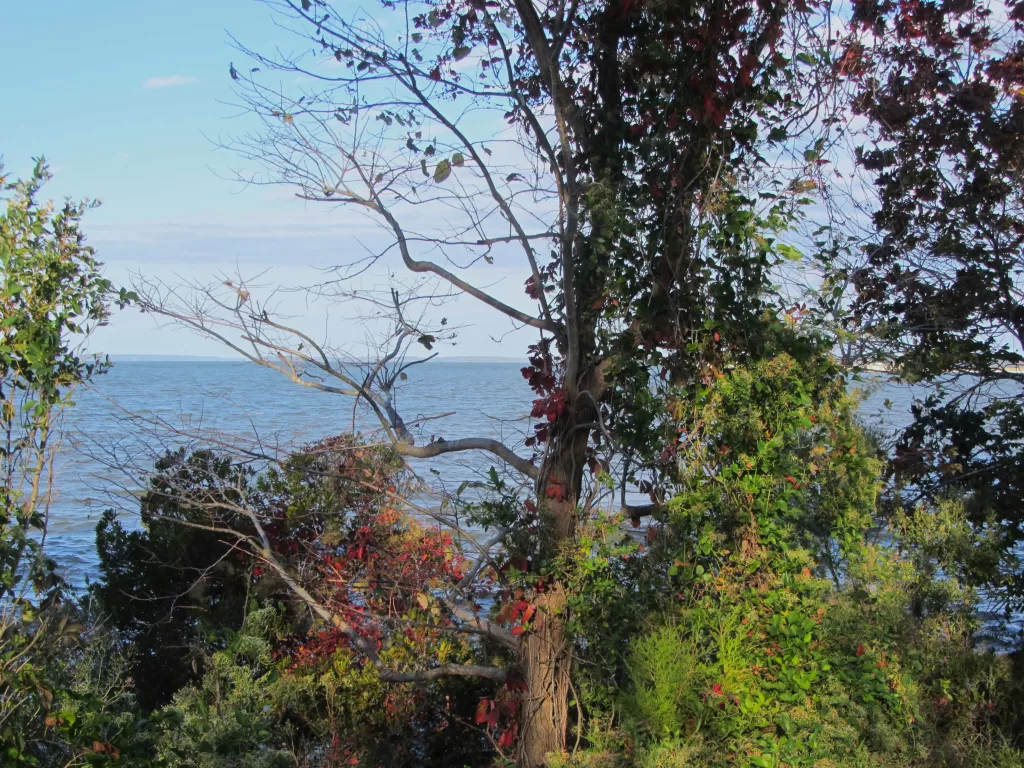Climbing Vines in Coastal Virginia
Vines of all types love our Coastal Virginia climate. Many different species thrive in summer’s heat and humidity, growing by inches each day. They creep across the ground until they encounter something to climb. Their tender, flexible tips reach up and out in search of a support, and then they climb.
Benefits of Vines
All vines in our area produce flowers and seeds. While some flowers are bright and showy, like the bright orange trumpet creeper, others are nearly invisible to the casual glance. Vines produce important food for wildlife and for people. Flowering vines support a variety of pollinators with their nectar and pollen. Many native vines serve as host plants for specific species of Lepidoptera, whose larvae eat their leaves. Some vine leaves, like grape leaves and certain species of Smilax, common greenbrier, are edible and medicinal. Grapes, and other vine fruits, feed both people and wildlife.
Consider how many staple foods grow on vines: beans, tomatoes, squash, pumpkins, melons and cucumbers. Then there are the more exotic fruits like passion fruit, kiwi fruit and groundnuts; and vining vegetables like kudzu and Malabar spinach.
Many native vines provided important raw materials to Indigenous Americans for making medicines, baskets, rope, and various tools.
Woody vines may be woven into wreathes and baskets, used for making furniture and fencing, and they create shade on arbors and fences. Evergreen vines, like Vinca and ivy make beautiful ground covers, particularly in dry shade, and were grown on brick buildings to cool and shade the building in summer. Flowering vines like Clematis and Wisteria are cultivated for their flowers.
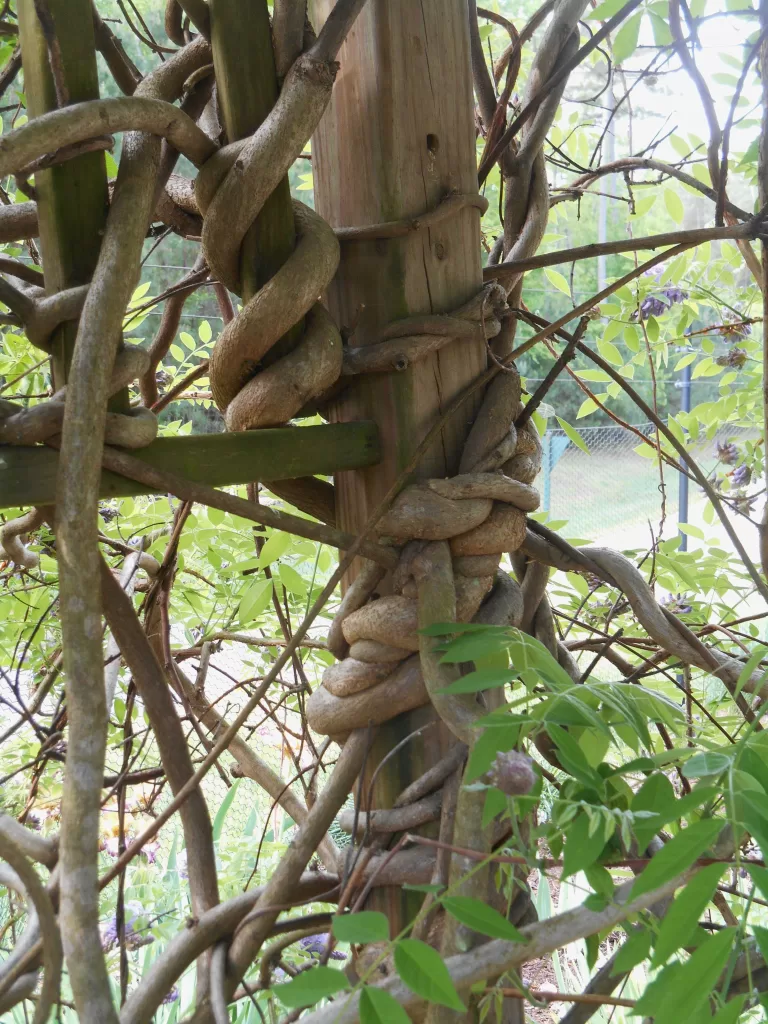
Native Wisteria twines around its trellis, and itself, at the Williamsburg Botanical Garden and Freedom Park Arboretum
How Vines Grow
Vines frequently earn a bad reputation as ‘invasive’ plants for their vigor and enthusiasm. Some vining plants, like kudzu, were originally imported to the United States to help stop erosion, provide fodder for animals, and because useful products may be made from their leaves and stems. Their vigor can turn a welcome addition to our botanical diversity into an invasive monster in only a few years, especially when the vine isn’t regularly pruned back or used in some way. Imported invasive vines produce seeds, spread by wildlife, and they spread vegetatively to conquer new territory.
When planting a new perennial vine, it is helpful to remember the adage, “At first they sleep, then they creep, until at last they leap!” A newly planted vine may not show much growth until the third spring after planting. Once its roots are established, it will grow rapidly.
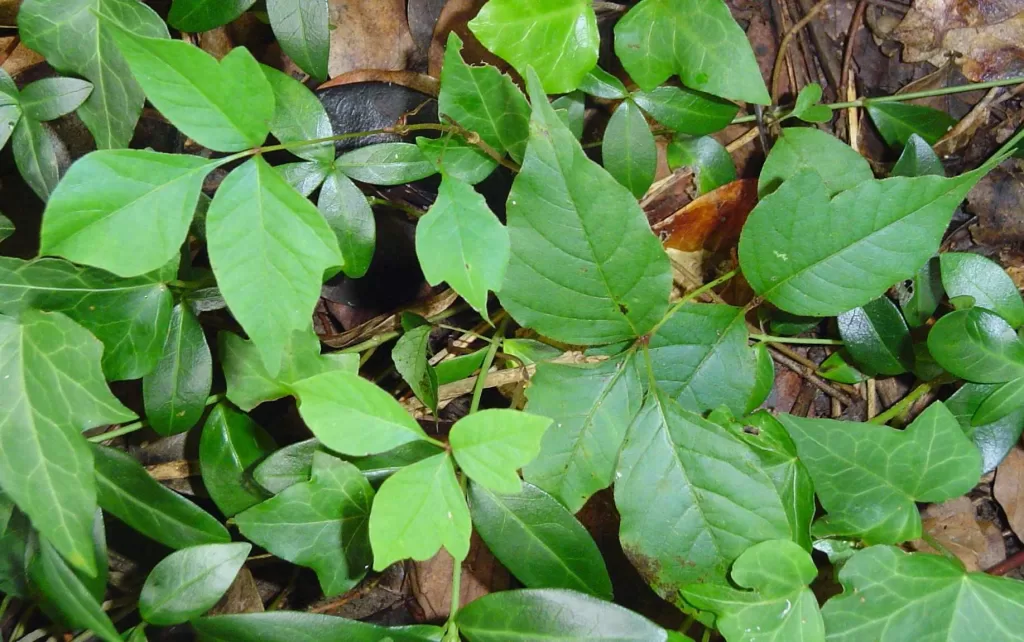
Poison ivy, English ivy, and Periwinkle mingle as ground cover. They can root at every leaf node that touches moist soil. When a vine finds a vertical support, it will begin to climb.
Cultivated vines are planted near a trellis or support of some sort that they can climb. Squash or melons may be planted on ‘hills’ and allowed to spread on the ground. Tender vines grown as annuals will die at the end of the season and so are less likely to become invasive.
Hardy vines imported for agricultural production, like European grape species, require careful, ongoing cultivation. They are trained onto trellises built from sturdy wooden uprights and wires. Then, the vines are pruned annually into a trunk and the main ‘branches’ tied into the wires. Finally, they are pruned hard each fall after the grape harvest to stimulate new growth for next year’s grape production. Grape vines allowed to grow without regular pruning and shaping quickly lose productivity.
How Vines Affect Trees
Once a wild vine finds a tree or other support, its growth accelerates. Vines climb the trunk and colonize tree branches, reaching ever higher and wider in search of sunlight. And this is where the vine begins to compete with the tree. In its search for sun, the vine’s leaves may begin to shade out the tree’s leaves.
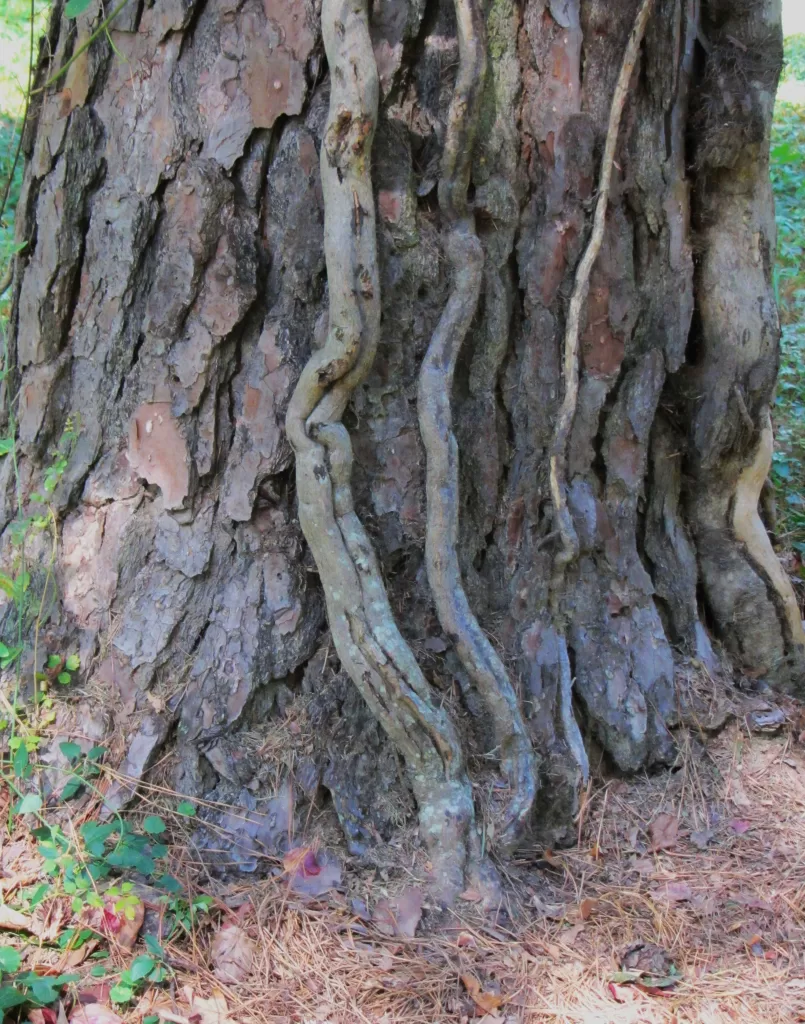
Trumpet vine and poison ivy vines have rooted beside this loblolly pine tree where they begin their ascent up its trunk.
It isn’t uncommon to find several species of native vine using the same tree for support. Loblolly pine trees, with their blocky bark, make particularly fine supports for trumpet vines and poison ivy. The vines grow heavier each year as their own stems and branches thicken into a rope like, woody, stems that may reach from tree to tree within a woodland. Drive through undisturbed woodlands in our area, and you may notice the thick, rope-like stems of grapevines hanging between older trees.
Some writers refer to woody vines as a type of tree or shrub. This isn’t really accurate because although a variety of vines grow woodier with age, very few can actually support the weight of their own growth to grow taller without using a fence, trellis, or another plant to support them. They don’t develop strong, upright trunks with a scaffolding of strong, stable branches as most shrubs and trees have. Even climbing roses, which begin their life as a small shrub, eventually require some sort of support for their long, and increasingly heavy, canes.
A tree may grow and remain healthy for many years after vines colonize it. In wild spaces, the vines may grow for decades without any maintenance, growing longer and stronger each year. The vine and tree may seem to be in balance.
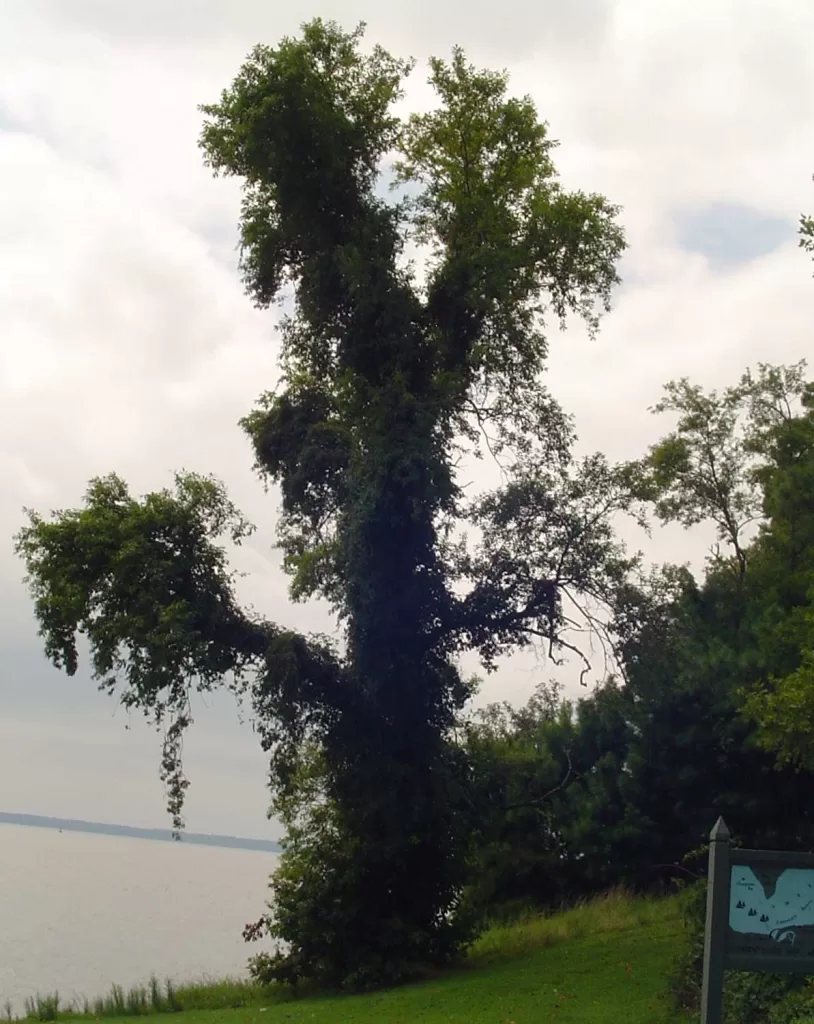
This tree stood for many years along the banks of the James River. Between erosion from the river, and the weight of its vines, the tree fell into the river. You will still find this tree lying in the river on your way to Jamestown Island.
Inevitable Decline
As the vines grow and a tree ages, the vine can impact the tree’s health and well-being. The ecosystem between vine and tree inevitably attracts various insects. Damage to the bark may allow bacteria and other pathogens to attack the tree. The tree may weaken once it is too shaded by the vine’s canopy. And the vine itself may act like a sail, or an anchor, in strong winds. When the ground is saturated from heavy rains, and there are strong winds, mature trees are vulnerable to blowing over. Having a heavy vine in the canopy makes the tree even more vulnerable to blowing down in the wind.
Parasite or Not?
I can’t find a single vine in our area which is a true parasite. Vines may use trees for support, but even those like poison ivy that climb by means of aerial rootlets use those roots to anchor themselves into the tree’s bark.
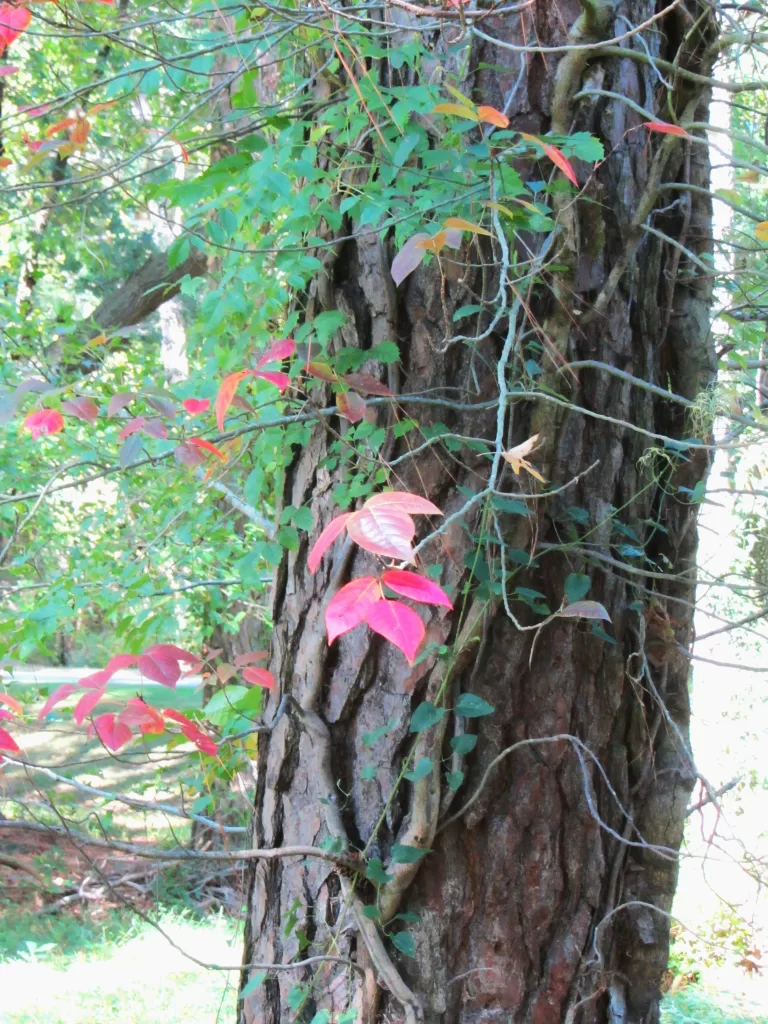
Poison ivy and trumpet vine have colonized this tree. Aerial rootlets anchor the vines into this pine tree’s bark.
These aerial rootlets may absorb rain, moisture from the bark, and ‘occult rain’ or dew and humidity. But they aren’t penetrating to the tree’s own circulatory system to feed from the tree. Vines have their own roots and circulatory system to support their own growth. They make their own food, like other plants, through photosynthesis.
Vine Propagation
Most vines not only produce abundant seeds, but they can easily root wherever a leaf node touches the moist ground (or bark) while the vine is still green and herbaceous. These additional roots allow the vine to grow even faster and further. Some vines develop runners, or stolons which creep across the ground, and specialized rhizomes or tubers below ground. Cuttings taken from many vines will easily root in water or soil, depending on the age of the cutting.
Like other plants, vines respond to ‘pruning’ with abundant new growth. This means that anyone who cuts back vines to control them should be prepared for new growth to emerge from the plants’ lower nodes, below the cuts. Eliminating a problematic vine must include eliminating the vines’ root system.
How They Climb
Different vining species use different mechanisms to climb. While English ivy and poison ivy produce aerial roots, grape vines, Vitis species, produce twining tendrils. These specialized stems can develop at each leaf node. Soft and pliable at first, once they twist themselves around a branch, wire, or other support, they harden and become strong and woody.
Some vines, like Wisteria ssp., twist their growing stems around a support. As they grow, they can eventually tighten too much around a growing stem and kill that branch. Some twining vines, like morning glory, are herbaceous and die back once hit by frost. Each type of vine develops its own mechanisms to climb and to cling.
How to Control Vines
It is nearly impossible to pull an established vine out of a tree. Grapes are especially tenacious with their woody tendrils holding tightly to the tree’s branches. Pulling vines with aerial roots will damage the tree’s bark. Yanking on strong, rope-like vines may break a tree’s branches.
The best way to deal with vines is to cut their main stems as close to the ground as possible to cut off water to the rest of the vine. It will quickly begin to wither and will drop its leaves. Remove as much of the vine as possible the following winter when the tree is dormant, and simply leave the rest of the vine to disintegrate naturally.
Many arborists will suggest painting the exposed stem of the vine, after making the first cuts to sever the body of the vine from its roots, with a systemic herbicide to kill the vine’s roots. This is the most effective way to deal with poison ivy, especially when it has colonized a tree. Be careful to wear gloves and long sleeves when working with poison ivy and other ‘poison’ vines that contain oils which irritate the skin.
Prior Planning….
Vines are beautiful and useful plants. But learn as much as possible about a species before introducing it to your garden. Understand that some species of vines will shade, crowd, and generally overpower other plants growing nearby. Wildlife will spread their seeds, which makes it easy for them to pop up unexpectedly. Watch for the first shoots of vines to ‘volunteer’ in your yard and remove those that are undesirable while they are small and easy to pull or dig up.
Always plan for an ornamental vine’s support before planting it. Be prepared to provide a larger and stronger support than you may think you need. I’ve watched Wisteria pry apart both porch railings and wooden trellises as it grows. Once a vine is established, prune it back each winter to control its size and keep it out of nearby trees. Once it grows beyond your reach, it really takes off and climbs on whatever support may be close enough to grab.
Here is a list of climbing vines common in our area. Other common ground cover vines, like Vinca minor, or Periwinkle, are covered in other articles on this website. As with any garden plant, or pet for that matter, observe it growing before adopting it. Learn as much as you can about a vine’s habits before you bring it home and introduce it to the family.
Climbing Vines Commonly Found in Eastern Virginia
Native Vines
Aristolochia macrophylla, Pipevine or Dutchman’s Pipe, herbaceous, deciduous vine to 40’ tall and 20’ wide in Zones 4-8
Type of climber: twining
Wildlife value: larval host to the Pipevine Swallowtail butterfly, flowers attract flies.
Value to humans: Ornamental, large leaves provide excellent screening on trellises and arbors.
Other information: All parts are highly toxic and can cause kidney failure if ingested. A European species of this genus was once used medicinally. The entire vine is highly flammable.
Bignonia capreolata, Cross vine, herbaceous vine to 50’ and 9’ wide in Zones 5-9
Type of climber: tendrils
Wildlife value: Flowers attract pollinators, deer eat the foliage.
Value to humans: Ornamental for showy flowers, has some medicinal properties.
Other information: Highly flammable, shade tolerant
Gelsemium sempervirens Carolina Jasmine, evergreen vine with thin, pliable stems that grows to 20’ tall and 30’ wide in Zones 6-10
Type of climber: twining
Wildlife value: Habitat, pollinators visit the flowers
Value to humans: Ornamental, glossy green leaves provide excellent screening on trellises and arbors.
Other information: All parts are extremely poisonous to humans if eaten.
Hydrangea Barbara, (formerly Decumaria barbara ) Climbing Hydrangea, woody, semi-evergreen or deciduous vine to 36’ in Zones 6-8
Type of climber: clinging aerial rootlets
Wildlife value: habitat, and attracts pollinators.
Value to humans: Ornamental, blooms on new wood. May be used as a groundcover, but only climbing stems bloom.
Other information: Extremely flammable, deer resistant
Parthenocissus quinquefolia, Virginia creeper, Zones 3-10, 30’-50’ tall, woody, deciduous vine.
Type of climber: tendrils, which end in ‘suction discs’ that hold the vine tightly to masonry and other surfaces. Branches to 10’ wide.
Wildlife value: habitat, flowers attract pollinators, fruits feed songbirds and small mammals
Value to humans: Ground cover and may be grown on masonry to cover walls. Scarlet in autumn.
Other information: Differentiate this vine from poison ivy because some leaf clusters contain five leaves, while others have 3. May cause irritation to those with sensitive skin, fruits poisonous, potentially fatal, if consumed.

Smilax bona-nox, Greenbriar, has medicinal properties and its tender shoots are edible raw or cooked.
Smilax bona-nox, S. glauca, Greenbrier, S. rotundifolia, Catbriar, S. walter,i Red Berried Greenbriar Semi-evergreen or deciduous vine to 20’ with prickles along its stems.
Type of climber: tendrils and prickles
Wildlife value: habitat, flowers attract pollinators, fruits eaten by a variety of birds and small animals.
Value to humans: some species have edible leaves, shoots, or roots and may be medicinal.
Other information: This vine is considered a nuisance in woodland thickets and scratches hikers and gardeners. It can grow into a dense net of stems.
Toxicodendron radicans Eastern Poison Ivy, woody, multi-branched deciduous vine to 60’-150’ in Zones 4-10. It also creeps along the ground and can form a small shrub to 6’ tall. All parts are highly poisonous.
Type of climber: Climbs straight up a tree using aerial roots that anchor it to the bark.
Wildlife value: Habitat, pollinators visit its flowers, birds and other animals eat the berries, deer and other animals will graze on the leaves.
Value to humans: Extremely poisonous and invasive, a rapid grower. Autumn color is deep scarlet.
Other information: All parts of the plant contain urushiol, a toxic oil, which causes severe and long-lasting skin irritations if touched. Some people are affected if they touch gloves or shoes which were in contact with the vine. When poison ivy plants are burned the oil is in the smoke, and can cause internal, systemic poison ivy infections.
Both Native and Non-native Vine Species
Campsis radicans, (native) Zones 4-10 or Campsis grandiflora (Asian) Zones 6-9 Trumpet vine 30’-40’ tall multi-stemmed woody deciduous vine to 10’ wide.
Type of climber: Climbs straight up a tree, clinging with aerial roots.
Wildlife value: hummingbirds and other pollinators visit flowers, deer and rabbits eat the foliage.
Value to humans: ornamental, for orange flowers
Other information: sap can irritate the skin, coarse foliage turns yellow in autumn, somewhat poisonous if eaten.
Clematis ssp. Clematis, Virgin’s Bower, Old Man’s Beard, etc., C. virginiana , Woodbine, (native) C. terniflora, Sweet Autumn Clematis, (Asian invasive) Woody, evergreen or deciduous vine to 6’-18’ in Zones 3-9
Type of climber: varies, most need to be tied in to a support- may be used as groundcover or grown over shrubs
Wildlife value: habitat, flowers attract pollinators, leaves may be a larval host, birds may eat seeds.
Value to humans: ornamental with showy flowers, some species used medicinally in Asian medicine
Other information: Highly toxic to humans and pets if ingested, may cause contact dermatitis if handled without gloves.
Ipomoea ssp. Over 600 species known as Morning Glory, Cypress Vine, Cardinal Climber, Sweet Potato, or Moonflower, deciduous vines in Zones 2-11. Native in North, South, Central America, parts of Asian and Africa, these vines are grown as annuals in our region.
Type of climber: Twining
Wildlife value: Hummingbirds and other pollinators are attracted to its flowers.
Value to humans: Vines are highly ornamental and attract pollinators. Some species have edible tubers. Seeds are considered poisonous to humans, but are used to create hallucinogenic substances.
Other information: Vines self-seed prolifically and may be considered weedy or invasive.
Lonicera ssp. L. sempervirens, Coral Honeysuckle (native, grows to 20’ tall and 6’ wide on semi-evergreen vines in Zones 4-9), L. japonica, Japanese/Chinese Honeysuckle (highly invasive semi-evergreen Asian species grows to 30’ and 6’ wide in Zones 5-8)
Type of climber: Vigorous, fast growing, twining
Wildlife value: Coral Honeysuckle attracts hummingbirds and other pollinators to its flowers, leaves are a larval host for native Lepidoptera, birds and small animals eat its fruits, deer may browse its leaves.
Value to humans: Highly ornamental flowering vine with a long period of bloom which attracts wildlife. Indigenous Americans used this plant medicinally.
Other information: Honeysuckle will creep as a groundcover but blooms best when climbing in full sun. It is highly flammable. Asian honeysuckle fruits are poisonous to humans if eaten.
Passiflora ssp. P. incarnata. Maypop (Zones 5-9 native), P. lutea Dwarf or Eastern Yellow Passionflower (Zones 5-10 native), P. caerulea Common Passionflower (Zones 6-10 native in S. America) herbaceous or woody stems to 40’
Type of climber: tendrils
Wildlife value: habitat, larval host plant, attracts hummingbirds and other pollinators, animals eat ripe fruits.
Value to humans: Highly ornamental flowers, edible fruits, some species used medicinally.
Other information: Highly flammable vines
Vitis ssp. Grapes V. rotundifolia, Muscadine grapes (Zones 5-9, native), V. vulpina Fox Grapes (Zones 5-10 native) V. vinifera table or wine grapes (Zones 6-10 European)
Type of climber: tendrils, which become woody
Wildlife value: habitat, pollinators visit the flowers, birds and other animals eat the fruits
Value to humans: Edible fruits and leaves
Other information: Needs regular pruning and care to keep under control and insure the quality of fruit. Vines can become invasive if not tended. Highly flammable.
Wisteria ssp. Wisteria frutescens, American Wisteria (native woody vine to 40’ tall and 8’ wide in Zones 5-9.) W. sinensis, Chinese Wisteria, (highly invasive woody Asian species to 20’ high and 30’ wide in Zones 5-8) W. floribunda, Japanese Wisteria (highly invasive and aggressive woody species to 25’ in Zones 4-9 that can be trained into a small tree or shrub.)
Type of climber: Twining
Wildlife value: Habitat, larval host for native Lepidoptera species, attracts pollinators
Value to humans: Highly ornamental, wood may be used for crafts, small construction, etc.
Other information: Seeds of American Wisteria are poisonous to pets and humans. All parts of Chinese Wisteria are poisonous to people and pets. Japanese Wisteria seeds and leaves are edible once cooked, and flowers may be eaten raw. American and Chinese Wisteria twines counter-clockwise, while Japanese species twine clockwise.
Non-Native Vines
Akebia quintata Chocolate Vine, woody, highly aggressive deciduous or semi-evergreen vine grows to 40’+ tall in Zones 5-8.
Type of climber: Twining
Wildlife value: Habitat, flowers attract pollinators, birds and other animals will eat the fruits and seeds.
Value to humans: Highly ornamental vines with beautiful spring flowers. It produces edible fruits if it has a pollinator. Strong woody vines are good for making baskets and wreathes.
Other information: Two vines are necessary for fruit production.
Hedera ssp. H. helix English Ivy, woody, aggressive evergreen vine to 80’ tall and 50’ wide in shade in Zones 4-13
Type of climber: Grows straight up a tree, or twists around it and attaches with aerial rootlets
Wildlife value: Habitat, pollinators visit flowers and fruits are eaten by birds and small animals.
Value to humans: Grown as an ornamental, low maintenance evergreen ground cover and to shade masonry walls. In Europe, ivy leaves have been used topically as an anti-microbial and anti-fungal medicine.
Other information: Considered invasive because it escapes cultivation and colonizes in disturbed areas. All parts are poisonous to humans and pets, if eaten. May cause contact dermatitis.
Pueraria montana, Kudzu Highly aggressive and fast-growing semi-woody, deciduous invasive vine native to Asia and Northern Australia. Grows to 100’ long and 20’ wide in Zones 5-10.
Type of climber: Twining
Wildlife value: Habitat, pollinators visit its flowers, birds and other animals eat its seeds.
Value to humans: Pueraria species have a variety of medicinal and culinary uses in Asia. Every part of the plant, including its gigantic tubers, are edible. The tubers may be dried and ground as flour, and its roots may be cooked and used as a thickening agent in soups and sauces.. Fibers from the stems and leaves are used to produce several useful products.
Other information: Kudzu stops erosion and increases soil fertility both by fixing nitrogen in the soil, and also by adding organic matter to the soil from its extensive root system. It sequesters carbon dioxide and other air pollutants in its deep roots.
For More Information:
Darke, Rick. The American Woodland Garden: Capturing the Spirit of the Deciduous Forest. Timber Press. 2002.
Mellichamp, Larry. Native Plants of the Southeast. Timber Press. 2014.
Oudolf, Piet and Henk Gerritsen. Planting the Natural Garden. Timber Press. 2019.
Robinson, William and Rick Darke. The Wild Garden: Expanded Edition. Timber Press. 2009.
Tallamy, Douglas. Bringing Nature Home- How You Can Sustain Wildlife with Native Plants. Timber Press. 2007.
Toth, Sally. Bird-by-Bird Gardening, The Ultimate Guide to Bringing in Your Favorite Birds Year After Year. Rodale Press. 2006.
Wasowski, Sally and Andy Wasowski. Gardening with Native Plants of the South. Taylor Publishing Company. 1994.
All photos by Elizabeth McCoy, Master Gardener Tree Steward.
Appreciation to the Williamsburg Botanical Garden and Freedom Park Arboretum where many of these photos were taken 2018-2022.

